Birds are an integral component of any ecosystem, and the jungle is no exception. These colorful creatures, with their enchanting tunes and intriguing behaviors, add a sense of life and vitality to the already bustling jungle environment.
The jungle is home to a diverse array of bird species, ranging from small, brightly colored songbirds to majestic birds of prey.
Each species has unique adaptations that allow them to thrive in the harsh and unpredictable jungle environment, making them a fascinating subject for bird enthusiasts and nature lovers alike.
In this article, we will explore the different types of birds that call the jungle home, their habitats, and how they contribute to the ecosystem.
1. Indian Roller
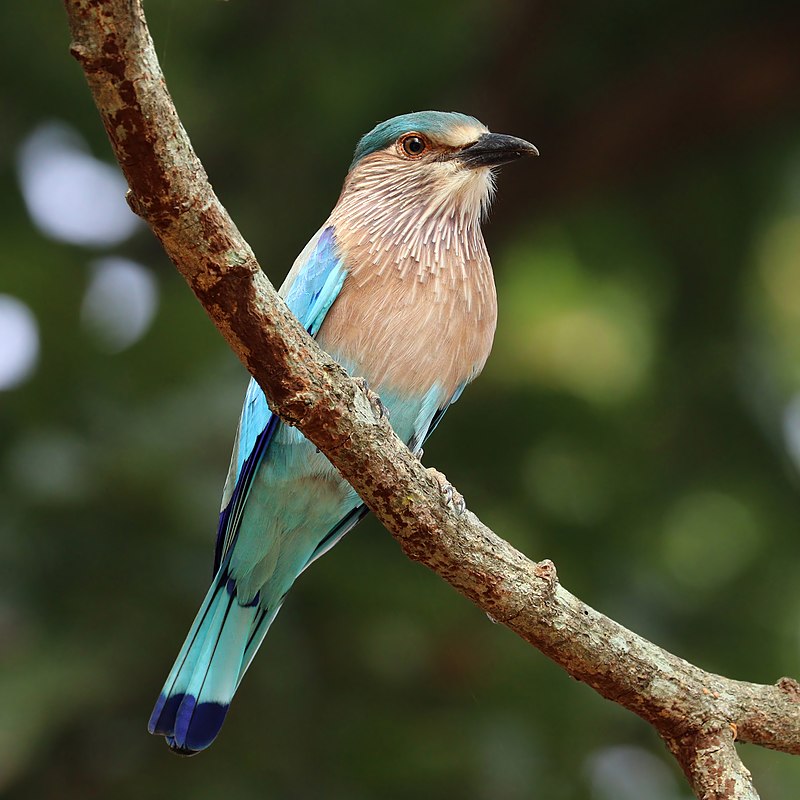
The Indian roller is a beautiful bird of the Coraciidae family. It has an average length of 12-13 inches and weighs 5.9 to 6.2 ounces with a wingspan of 26-29 inches.
Its face and throat are pinkish, while its head and back are brown with blue on its rump, light blue markings on one side of the wing, dark blue markings on other side making it easily distinguishable in flight.
Both male and female have same colouration but males tend to be slightly larger than females though they can only be differentiated when seen together closely due to similar colouring pattern between sexes.
The Indian Roller makes spectacular aerial dives from great heights during courtship display which attracts many viewers each year.Scientific classification:
| Kingdom | Animalia |
| Phylum | Chordata |
| Class | Aves |
| Order | Coraciiformes |
| Family | Coraciidae |
| Genus | Coracias |
| Species | C. benghalensis |
Also Featured In: Common Birds in India, Birds that Live in Tamil Nadu
2. Red Junglefowl
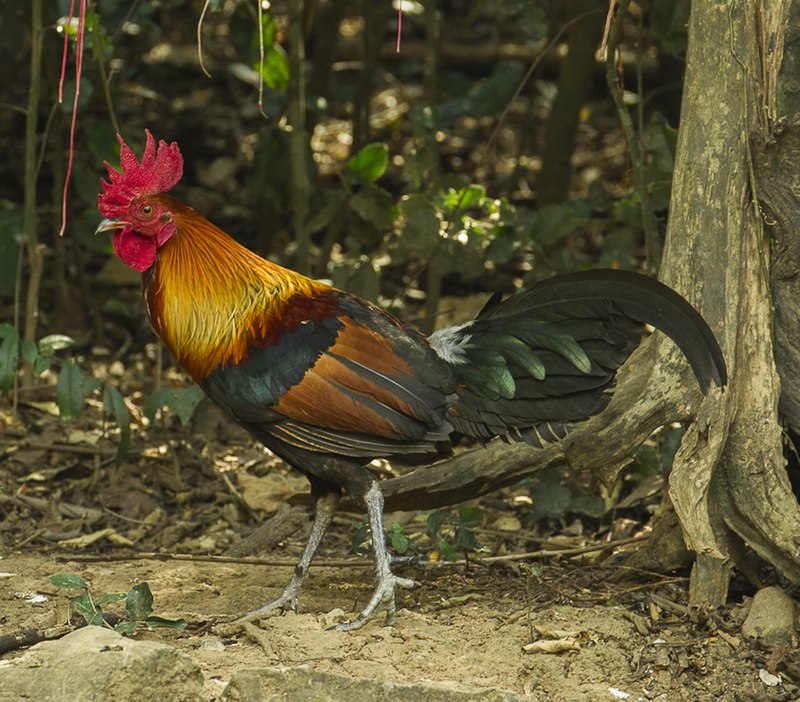
The Red Junglefowl is a tropical bird belonging to the Phasianidae family, native to much of Southeast Asia and parts of South Asia. It has been referred to as Bankiva or Bankiva Fowl in the past.
This species was instrumental in giving rise to chickens (Gallus gallus domesticus) that are commonly domesticated today.
In addition, it has contributed genetic material along with Grey Junglefowl, Sri Lankan Junglefowl and Green Junglefowl towards creation of various breeds found around the world.
The male red jungle fowls have a distinctive long tail while they also boast iridescent patches on their neck feathers which develop during mating season for display purposes.
They mainly feed on plants & insects but may occasionally consume lizards too.Scientific classification:
| Kingdom | Animalia |
| Phylum | Chordata |
| Class | Aves |
| Order | Galliformes |
| Family | Phasianidae |
| Genus | Gallus |
| Species | G. gallus |
Also Featured In: Birds of Kauai, Hawaii, Beautiful Birds Found in Coron Island
3. Birds-Of-Paradise
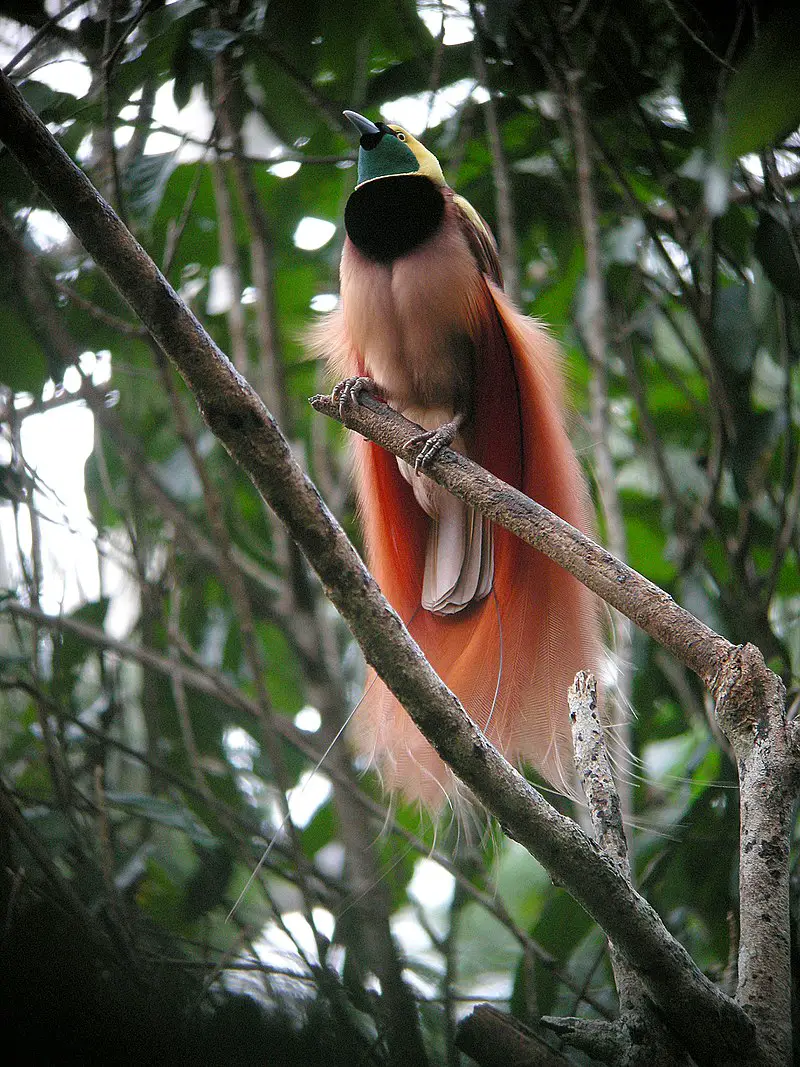
The birds-of-paradise are a family of passerines found mainly in eastern Indonesia, Papua New Guinea and eastern Australia.
These fascinating creatures have 45 species divided into 17 genera and are best known for their vibrant plumage.
Males of the species tend to be more colourful than females, with bright colours such as reds, blues and greens often seen on their feathers.
Their elaborate courtship displays also make them quite unique among other birds; they use various visual cues to attract mates including plumes, tail feathers and even dances.
The diversity of these stunning creatures makes them one of the most captivating bird families in existence today.Scientific classification:
| Kingdom | Animalia |
| Phylum | Chordata |
| Class | Aves |
| Order | Passeriformes |
| Superfamily | Corvoidea |
| Family | Paradisaeidae Swainson, 1825 |
Also Featured In: Beautiful Indonesian Birds,
4. Jungle Babbler
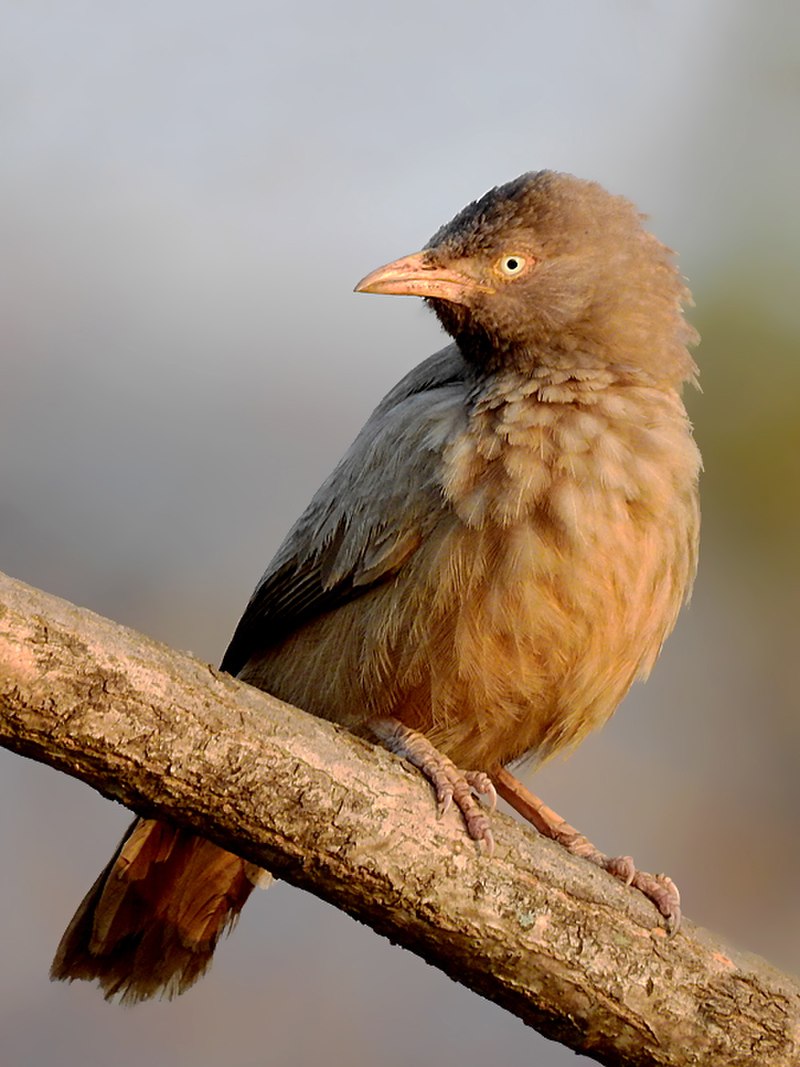
The Jungle Babbler is a member of the Leiothrichidae family, native to India.
It’s known for its gregarious nature and often forms small groups up to 10 birds while they search for food – this habit has earned them the nickname ‘Seven Sisters’ in Northern India, or Saath Bhai (seven brothers) in Bengali.
This colourful bird typically grows around 20 cm long with olive-brown plumage and a black eyestripe running through each eye; it also sports yellowish legs which contrast nicely against their feathers.
The jungle babbler is an omnivore that consumes insects as well as fruits, flowers and nectar from plants.
They are predominantly found near dense forests but may move into shrublands when seasonal changes occur or if there’s a lack of resources available within the forest environment.
With its cheerful call being heard throughout much of Southern Asia, these social birds make great additions to any garden setting.Scientific classification:
| Kingdom | Animalia |
| Phylum | Chordata |
| Class | Aves |
| Order | Passeriformes |
| Family | Leiothrichidae |
| Genus | Argya |
| Species | A. striata |
Also Featured In: Native Pakistani Birds, Delhi Birds You Need to See
5. Toco Toucan
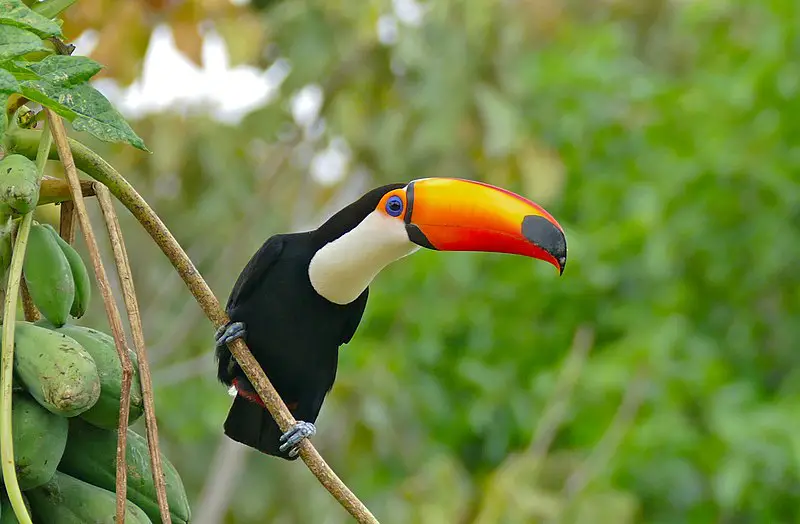
The Toco Toucan is the largest and most recognizable species of toucans, native to semi-open habitats in Central and Eastern South America.
First described by German zoologist Philipp Ludwig Statius Müller in 1776, this colorful bird has two subspecies – Ramphastos toco toco and Ramphastos toco cuvieri – distinguished by their slightly different size, plumage coloration, beak markings and range.
With its large orange bill covered with black spots along the sides of its face contrasting with yellow feathers on top of its head , it’s a very striking animal indeed.
Commonly found in zoos around the world too due tot heir loveable nature they are often kept as pets. They feed mainly on fruit but may also eat insects or small reptiles from time to time.
All in all these birds provide us a wonderful spectacle that we should appreciate for many years ahead.Scientific classification:
| Kingdom | Animalia |
| Phylum | Chordata |
| Class | Aves |
| Order | Piciformes |
| Family | Ramphastidae |
| Genus | Ramphastos |
| Species | R. toco |
Also Featured In: Beautiful Brazilian Birds, Most Common Birds in South America Birds
6. Toucans
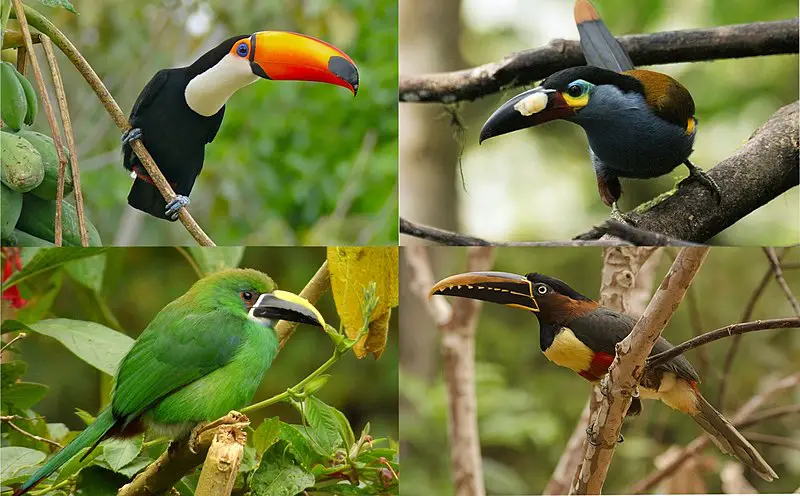
Toucans are members of the Ramphastidae family, which is closely related to American barbets. These birds have brightly-colored feathers and large beaks that come in a variety of colors.
They tend to live high up in trees, where they make their nests with two or four white eggs inside.
Toucans typically feed on fruits and sometimes small insects as well. Some species can even catch larger animals such as reptiles and amphibians for food.
Although toucans like to keep close together when living in groups, during breeding season they become more aggressive towards each other due to competition over resources like nesting sites or food sources.Scientific classification:
| Kingdom | Animalia |
| Phylum | Chordata |
| Class | Aves |
| Order | Piciformes |
| Infraorder | Ramphastides |
| Family | Ramphastidae Vigors, 1825 |
Also Featured In: Famous Paintings Birds,
7. Hyacinth Macaw
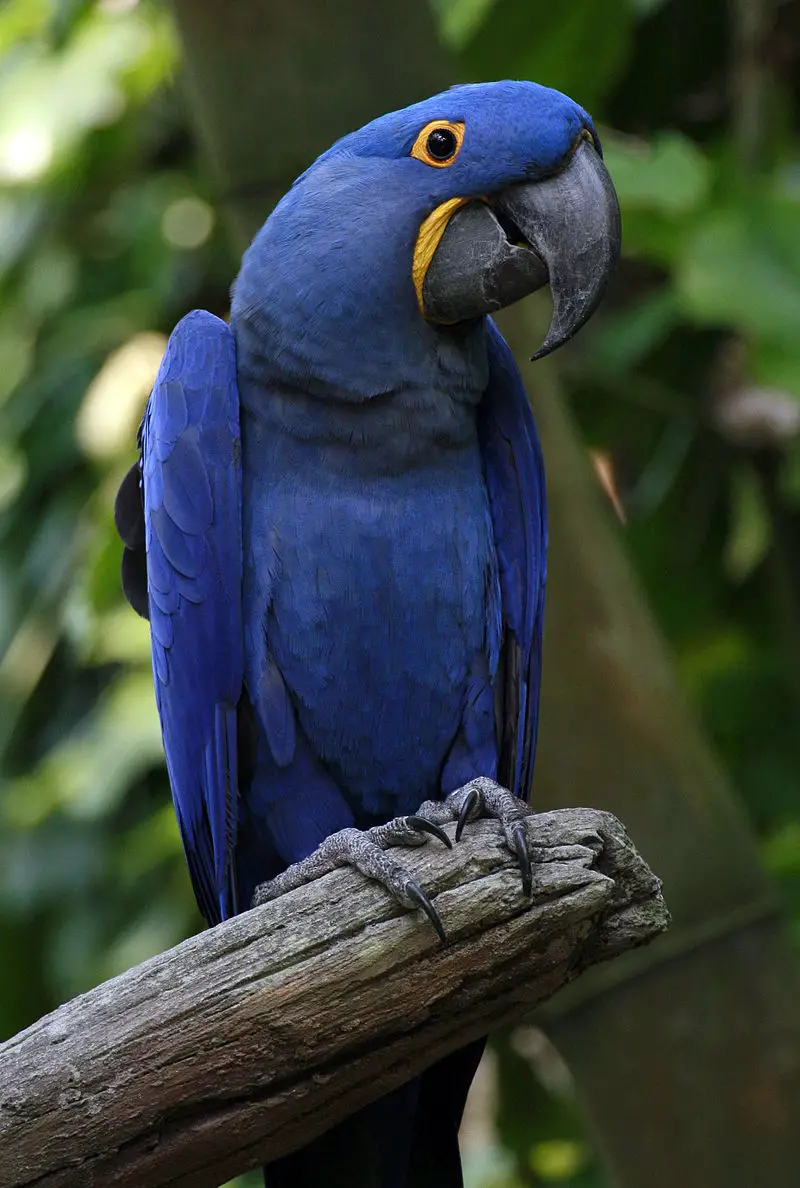
The Hyacinth Macaw is an extraordinary bird, known for its impressive size and vibrant coloration.
It has a length of around one meter, making it the longest parrot species in existence as well as the largest flying parrot species; even larger than 3.5 kg flightless Kākāpō from New Zealand.
Its striking blue plumage with yellow at its wingtips gives this majestic bird an eye-catching appearance that’s sure to turn heads wherever it goes.
Native to central and eastern South America, these birds are highly intelligent creatures who form strong bonds with their owners when kept in captivity.
They make great companions if given proper care and attention which includes providing them with plenty of space for exercise and enrichment activities such as playtime out of the cage on occasion or teaching them tricks using positive reinforcement methods like verbal praise or food rewards.Scientific classification:
| Kingdom | Animalia |
| Phylum | Chordata |
| Class | Aves |
| Order | Psittaciformes |
| Family | Psittacidae |
| Genus | Anodorhynchus |
| Species | A. hyacinthinus |
Also Featured In: Blue Birds You’ll Found around Us, Common Latin America Birds
8. Scarlet Macaw
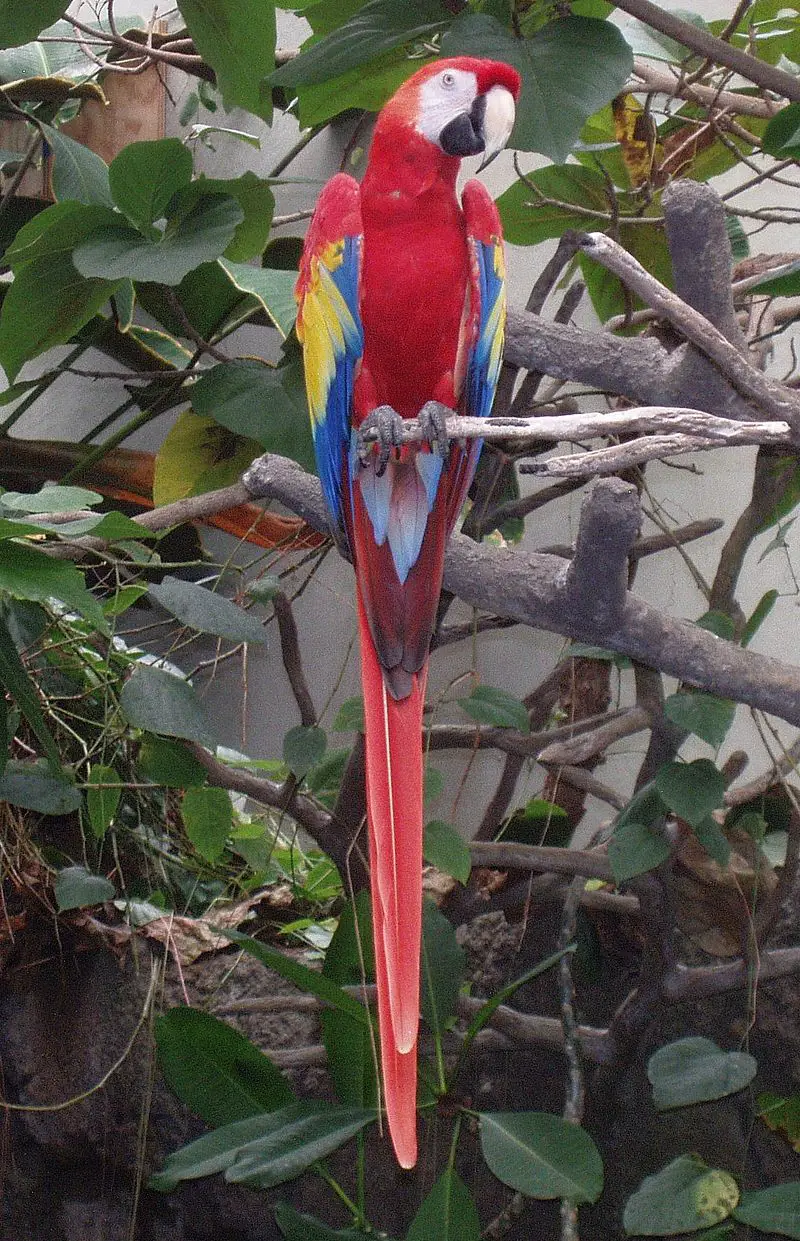
The Scarlet Macaw is a vibrant and beautiful bird found in Central and South America. Its striking red, yellow, and blue feathers make it stand out among other parrots.
It inhabits humid evergreen forests of the Neotropics from Mexico to Peru, Ecuador, Colombia, Bolivia Venezuela Brazil up to an altitude of 1000m (3300ft).
These birds have strong beaks which they use for breaking open hard nuts or seeds that would otherwise remain inaccessible.
They also form social bonds with their mates by grooming eachothers’ feathers and engaging in playful activities such as chasing one another around tree trunks.
Despite its vivid colors the Scarlet Macaw remains vulnerable due to habitat loss caused by deforestation so conservation efforts are essential if this amazing species is going to survive for future generations.Scientific classification:
| Kingdom | Animalia |
| Phylum | Chordata |
| Class | Aves |
| Order | Psittaciformes |
| Family | Psittacidae |
| Genus | Ara |
| Species | A. macao |
Also Featured In: Spiritual Birds, Case Birds that Live in with Us
9. Hoatzin
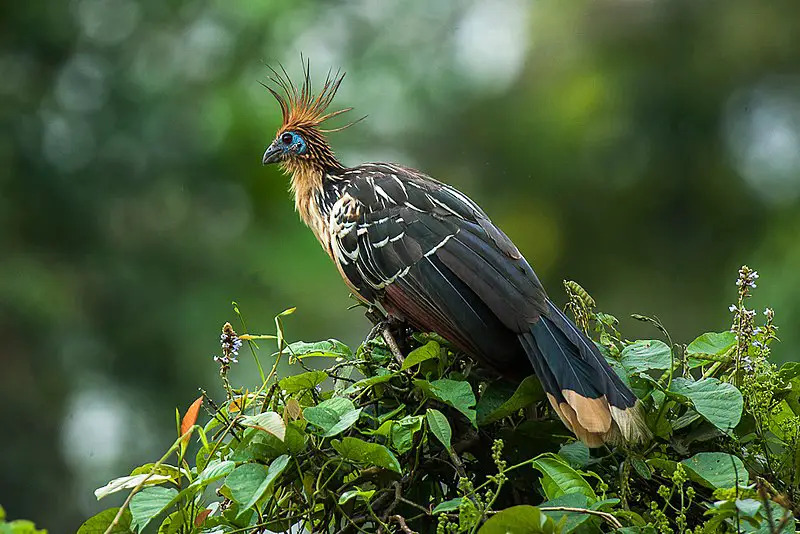
The Hoatzin bird is a tropical species found in the Amazon and Orinoco river basins of South America. It inhabits swamps, riparian forests and mangroves.
This unique bird has chicks that have claws on two of their wing digits which make it the only member in its order – Opisthocomiformes.
Its most distinctive feature is an odour produced from its digestive system which smells like cow manure.
The adults are brownish-grey with blue facial skin, red eyes, pointed crest feathers and black primaries.
They feed mainly on leaves but also eat flowers, fruits or buds when available during different seasons.
They can be heard making loud calls resembling caws at night time as well as repeated whistles throughout the day to keep contact between family members within flocks.Scientific classification:
| Kingdom | Animalia |
| Phylum | Chordata |
| Class | Aves |
| Order | Opisthocomiformes |
| Family | Opisthocomidae |
| Genus | Opisthocomus Illiger, 1811 |
| Species | O. hoazin |
Also Featured In: Birds that Live in Guyana,
10. Amazon Kingfisher
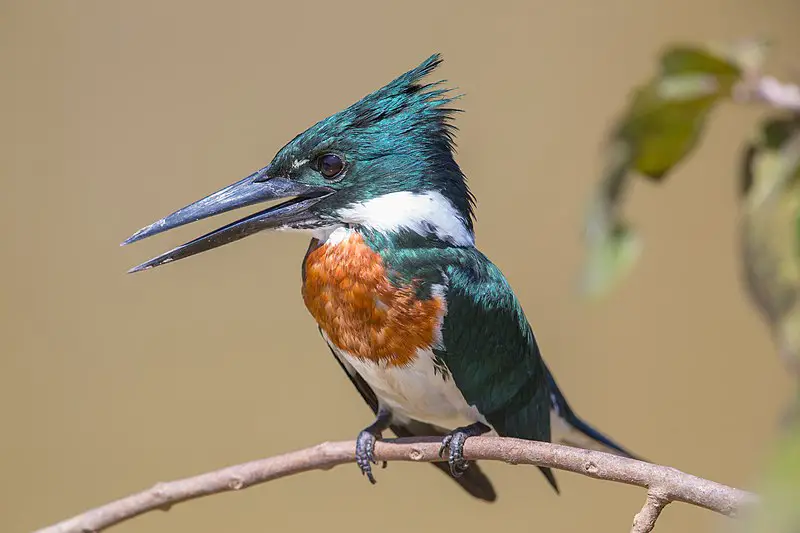
The Amazon Kingfisher is a stunning species of water kingfisher found in the lowlands of Central and South America.
It has an aqua-green head, chestnut wings with white markings, blue back and tail and yellow feet.
Its dramatic plumage makes it one of the most attractive birds in its region.
The Amazon Kingfisher can be seen perching on branches or flying close to slow moving rivers while they search for food such as fish, frogs, lizards or insects which they catch by diving into the water from above.
Despite their colorful appearance these bird are incredibly shy so it’s difficult to get too close without scaring them away.Scientific classification:
| Kingdom | Animalia |
| Phylum | Chordata |
| Class | Aves |
| Order | Coraciiformes |
| Family | Alcedinidae |
| Subfamily | Cerylinae |
| Genus | Chloroceryle |
| Species | C. amazona |
Also Featured In: Birds that You’ll Find in Chiapas, Most Common Oaxaca Birds
11. Coppersmith Barbet
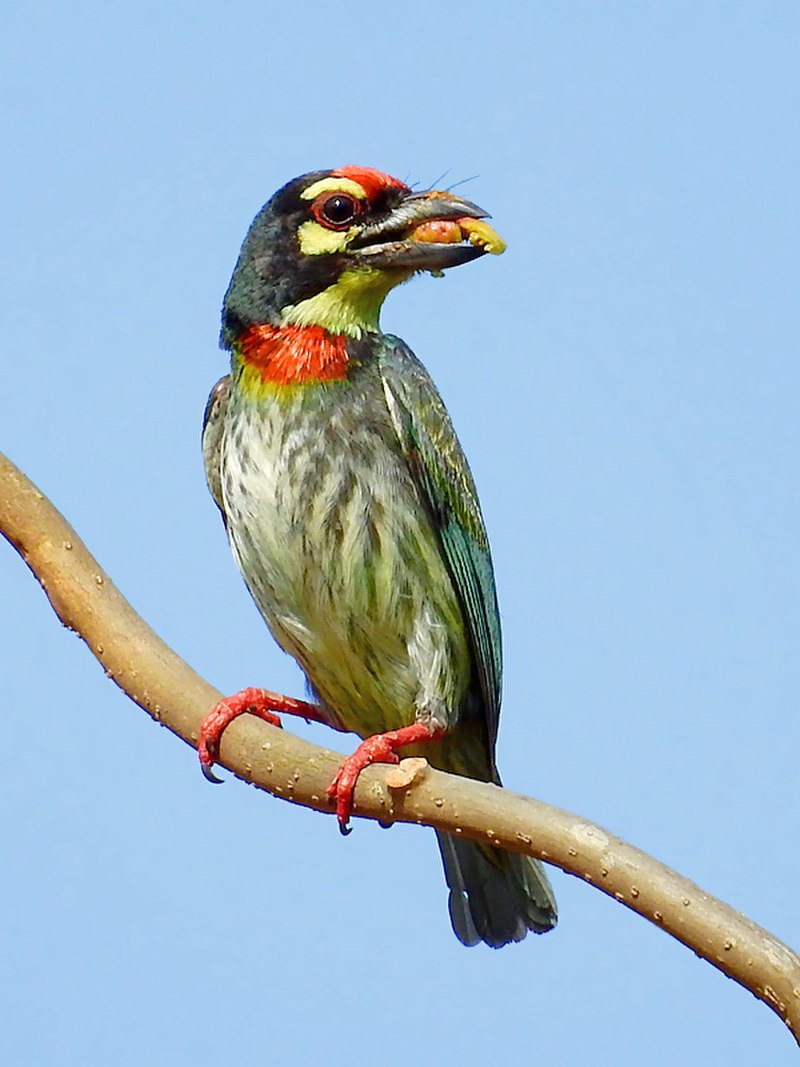
The Coppersmith barbet is an attractive Asian bird, easily recognizable by its bright crimson forehead and throat.
It has a call that sounds like a coppersmith striking metal with a hammer – hence its name.
These birds are found in the Indian subcontinent and parts of Southeast Asia where they build their nests inside trees, carving out holes for themselves.
They can often be seen perched high up on trees or wires during the day as they feed on fruit from nearby branches.
The vibrant colors of these birds make them stand out amongst other species in their habitat.Scientific classification:
| Kingdom | Animalia |
| Phylum | Chordata |
| Class | Aves |
| Order | Piciformes |
| Family | Megalaimidae |
| Genus | Psilopogon |
| Species | P. haemacephalus |
Also Featured In: Most Common Types of Bangladeshi Birds, Common Birds of Mumbai
12. Hornbill
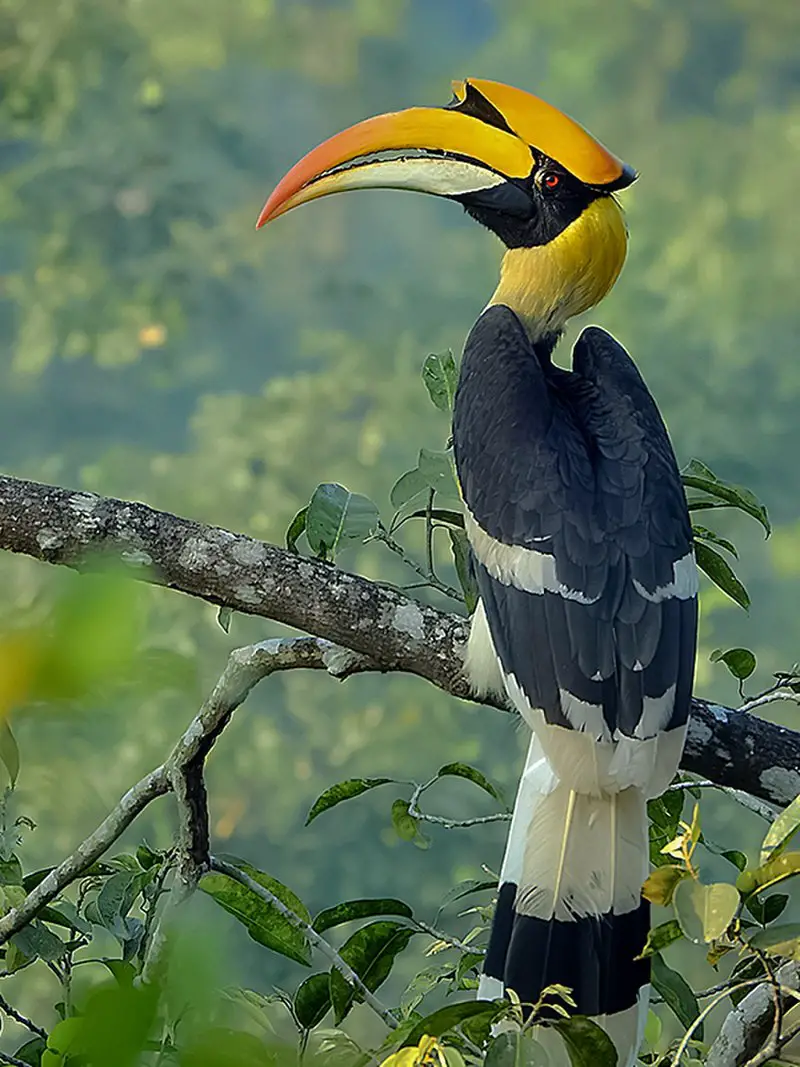
Hornbills are a tropical and subtropical bird species with characteristic long, curved bills. Their English and scientific names both refer to the shape of their bill which resembles that of a cow’s horn.
They have strong beaks for cracking open hard-shelled fruits as well as powerful wings for flying between trees or over great distances in search of food or mates.
Hornbills also feature beautiful plumage ranging from white to black feathers with yellow, brown, red and blue accents on the head, neck and back areas depending on the species.
In addition they often display brightly coloured casques – helmet like structures – atop their upper mandible adding further visual appeal to these majestic birds.Scientific classification:
| Kingdom | Animalia |
| Phylum | Chordata |
| Class | Aves |
| Order | Bucerotiformes |
| Family | Bucerotidae Rafinesque, 1815 |
Also Featured In: Birds of South African, African Birds
13. Great Hornbill
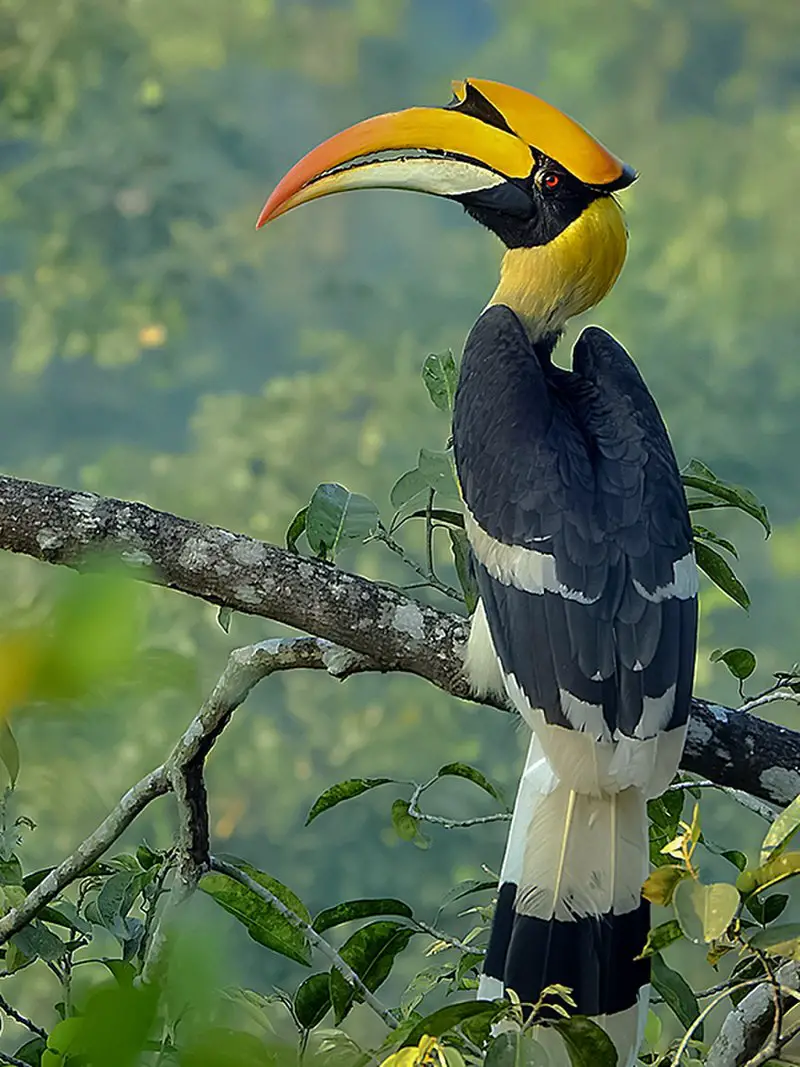
The Great hornbill is an impressive bird, belonging to the family of Hornbills. It can be found in India and Southeast Asia, mainly eating fruits but also preying on small mammals, reptiles and birds.
Its striking looks include a concave casque which sits atop its head as well as vibrant yellow-orange feathers covering much of its body.
Unfortunately it’s listed by IUCN Red List since 2018 due to habitat loss resulting from deforestation for agriculture and timber logging activities taking place across the world today.
Despite this sad news there are still conservation measures being taken such as education programs focusing on sustainable farming practices that will help protect this amazing species’ future.Scientific classification:
| Kingdom | Animalia |
| Phylum | Chordata |
| Class | Aves |
| Order | Bucerotiformes |
| Family | Bucerotidae |
| Genus | Buceros |
| Species | B. bicornis |
Also Featured In: Birds of Myanmar, Common Birds in Kerala
14. Andean Cock-Of-The-Rock
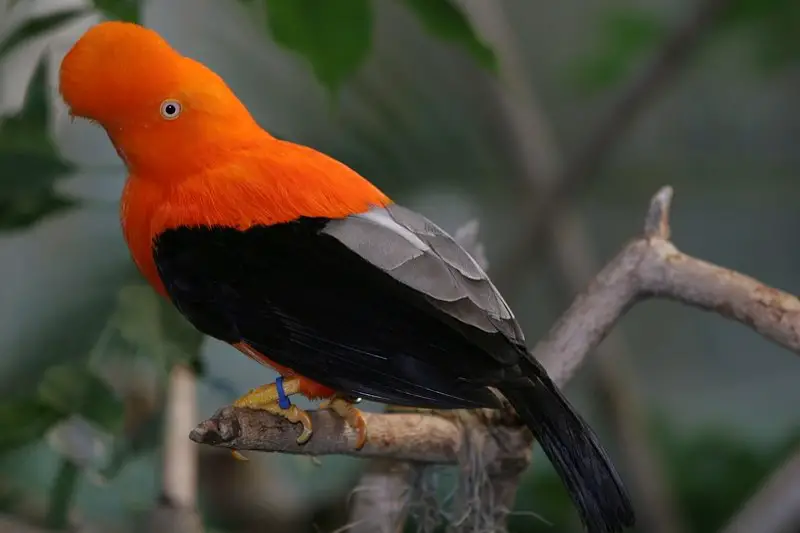
The Andean cock-of-the-rock is a large passerine bird belonging to the Cotinga family. It has four subspecies and can be found in the cloud forests of South America, notably Peru where it has been declared its national bird.
This species exhibits marked sexual dimorphism; males have an impressive orange crest that covers most of their head as well as a bright coral chest patch while females are mainly grey with dark wings and tail feathers.
Both sexes also feature black heads, yellow eyes, long bills and short legs.
Their diet consists mostly of fruits but they have also been known to eat small insects for protein.
They are monogamous birds who mate for life forming strong pair bonds that last several years until one partner dies or moves away from its territory.Scientific classification:
| Kingdom | Animalia |
| Phylum | Chordata |
| Class | Aves |
| Order | Passeriformes |
| Family | Cotingidae |
| Genus | Rupicola |
| Species | R. peruvianus |
Also Featured In: Common Birds in Colombia,
15. Keel-Billed Toucan
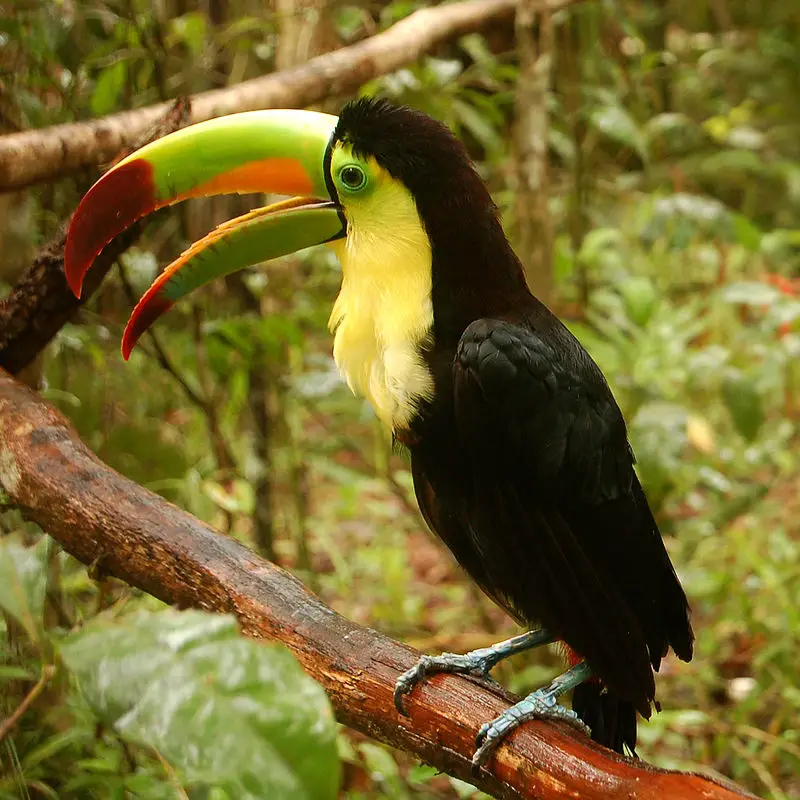
The Keel-billed Toucan is a vibrant Latin American bird from the toucan family and also serves as Belize’s national bird. They are found in tropical jungles stretching all the way from southern Mexico to Colombia.
They feed on fruits, seeds, insects, lizards and snakes – being omnivorous birds they eat pretty much anything.
These colourful creatures have an impressive beak with green upper parts of their bodies coupled with yellow lower halves.
The underside of their tail feathers are black while its tips remain white creating for quite a stunning display when flying or perched atop tree branches.Scientific classification:
| Kingdom | Animalia |
| Phylum | Chordata |
| Class | Aves |
| Order | Piciformes |
| Family | Ramphastidae |
| Genus | Ramphastos |
| Species | R. sulfuratus |
16. King Vulture
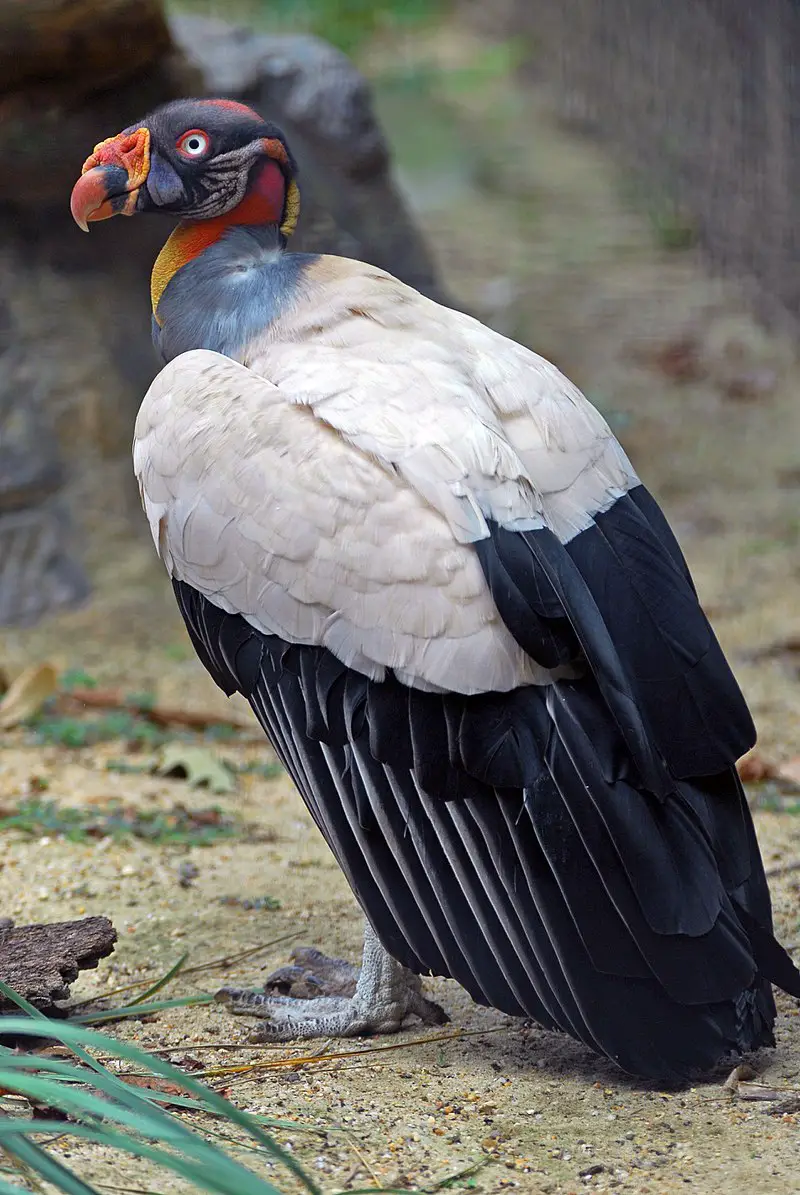
The King Vulture is a majestic bird found in Central and South America. It has striking white plumage with black accents, and its head is topped by a bright yellow crest.
With long wingspan of up to 4 feet, this vulture soars gracefully through the sky. Its large size allows it to dominate other scavenging birds at carcasses; although not as powerful as some raptors, the king vulture will protect what belongs to it fiercely.
The diet of these elegant creatures consists mainly of carrion such as dead mammals or fish that they spot from far away using their excellent vision.
They also occasionally eat eggs or nestlings if food is scarce during dry seasons.
This fascinating species plays an important role in keeping ecosystems healthy by removing dead animals from landscapes quickly before diseases spread further into populationsScientific classification:
| Kingdom | Animalia |
| Phylum | Chordata |
| Class | Aves |
| Order | Accipitriformes |
| Family | Cathartidae |
| Genus | Sarcoramphus |
| Species | S. papa |
Also Featured In: Scavengers Birds You Should Know, Common Carnivore Birds
17. Harpy Eagle
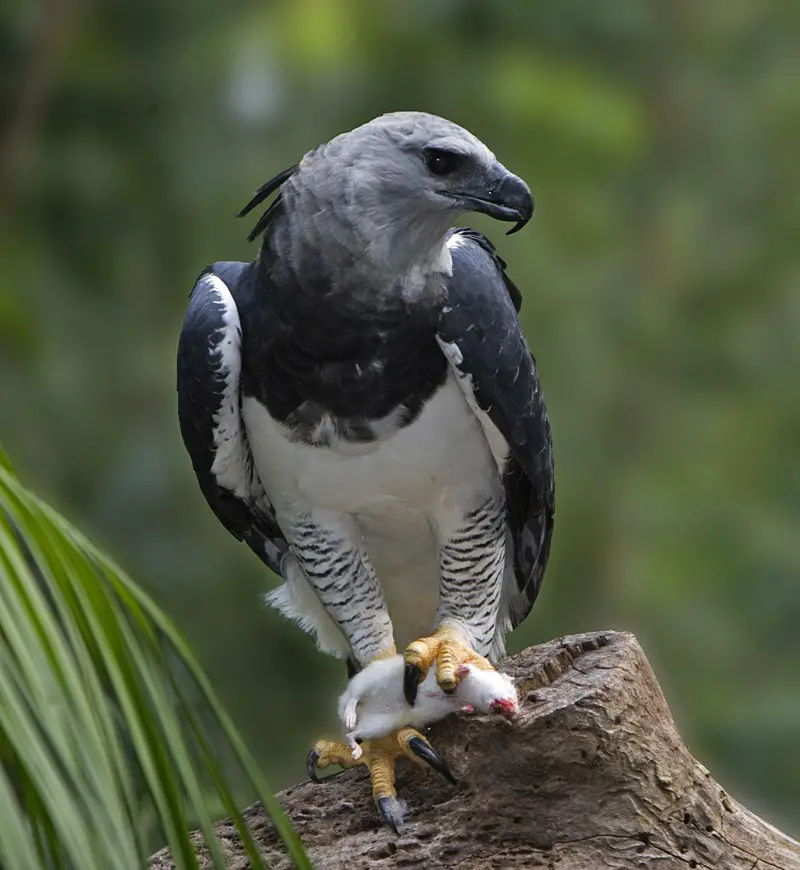
The Harpy Eagle is a magnificent bird of prey found in the tropical forests of Central and South America. It is the largest eagle on Earth, possessing an impressive wingspan that can reach up to 7 feet across.
Its powerful talons are its most distinguishing feature, being able to grasp even large animals such as monkeys or sloths with ease.
The majestic raptor has slate-gray feathers on its back and head which contrast against white undersides and yellow legs.
These birds live alone for much of their life but will come together during breeding season when they construct elaborate nests high off the ground in tall trees.
People have long been fascinated by this species’ impressive size and strength—it truly deserves its nickname as “the lord of skies”.Scientific classification:
| Kingdom | Animalia |
| Phylum | Chordata |
| Class | Aves |
| Order | Accipitriformes |
| Family | Accipitridae |
| Subfamily | Harpiinae |
| Genus | Harpia Vieillot, 1816 |
| Species | H. harpyja |
18. Horned Screamer
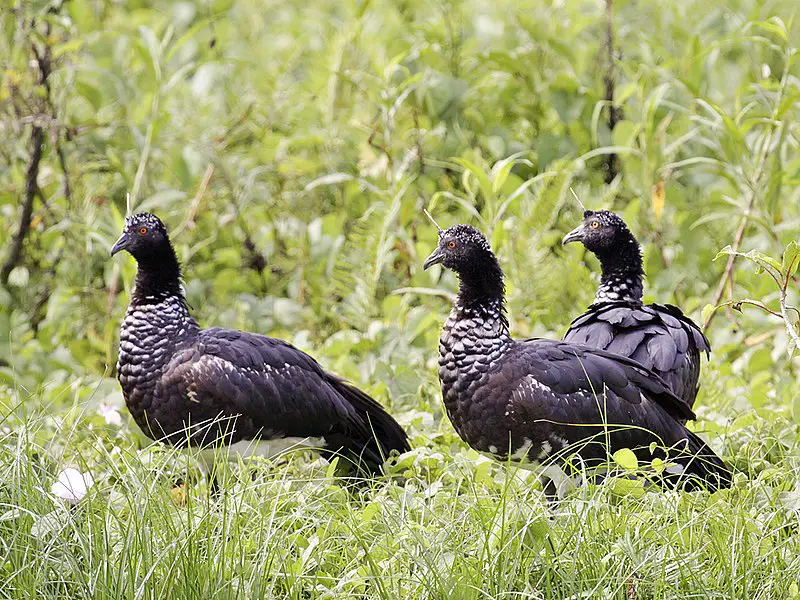
The Horned screamer is a unique species of bird found in the wetlands of tropical South America. It belongs to the Anhimidae family and is related to ducks, geese and swans, which are all part of the Anatidae family.
The most distinctive feature about this particular species is its large protruding horns on top of its head.
These help them protect themselves from predators as well as make loud calls when they feel threatened or need to alert their flockmates that danger may be near.
They also have powerful legs for swimming through water and can reach speeds up to 40 km/h.
Despite their small size compared with other members within their families, these birds can live up to 20 years old in captivity which makes them an interesting addition any wildlife enthusiast’s collection.Scientific classification:
| Kingdom | Animalia |
| Phylum | Chordata |
| Class | Aves |
| Order | Anseriformes |
| Family | Anhimidae |
| Genus | Anhima Brisson, 1760 |
| Species | A. cornuta |
Also Featured In: Most Unique Birds in Peru,
19. Parrots
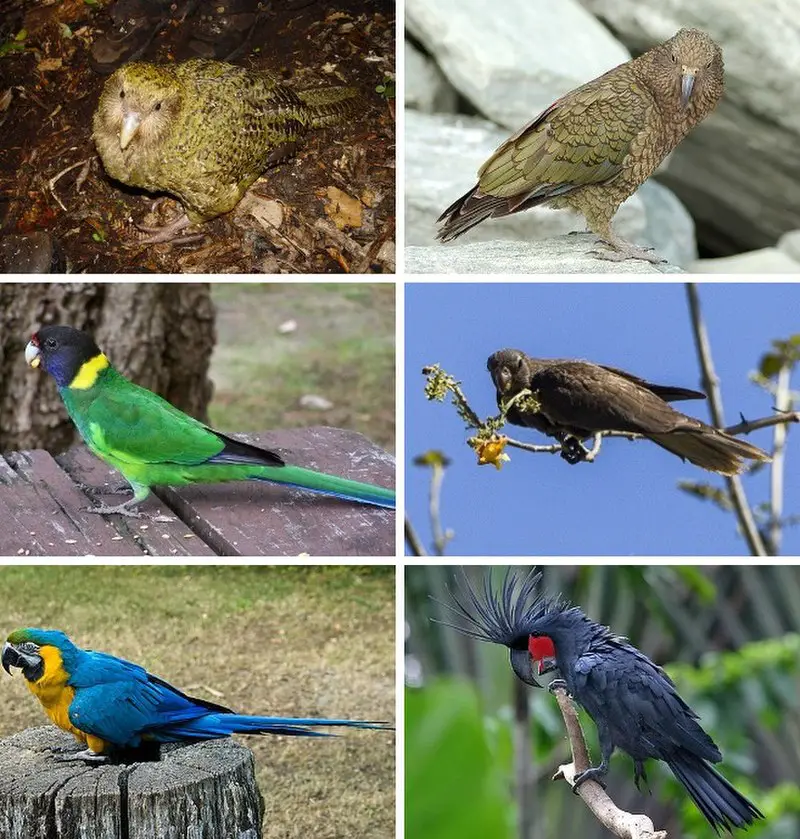
Parrots are a diverse group of birds, found in tropical and subtropical regions. They make up the order Psittaciformes, which is divided into three superfamilies: “true” parrots (Psittacoidea), cockatoos (Cacatuoidea) and New Zealand Parrots (Strigopoidea).
Many species have brightly colored feathers that can be red, yellow or blue. Their strong curved bills allow them to feed on fruits, nuts and seeds.
Parrot behavior ranges from playful to aggressive depending on their environment and socialization with humans.
Some even learn human words. As beloved pets they bring joy to many households around the world though it’s important for owners to understand how best to care for these intelligent creatures so as not to cause distress or harm.Scientific classification:
| Kingdom | Animalia |
| Phylum | Chordata |
| Class | Aves |
| Clade | Psittacopasserae |
| Order | Psittaciformes Wagler, 1830 |
Also Featured In: Most common birds in Australia, Italian Birds You Should Know
20. Resplendent Quetzal
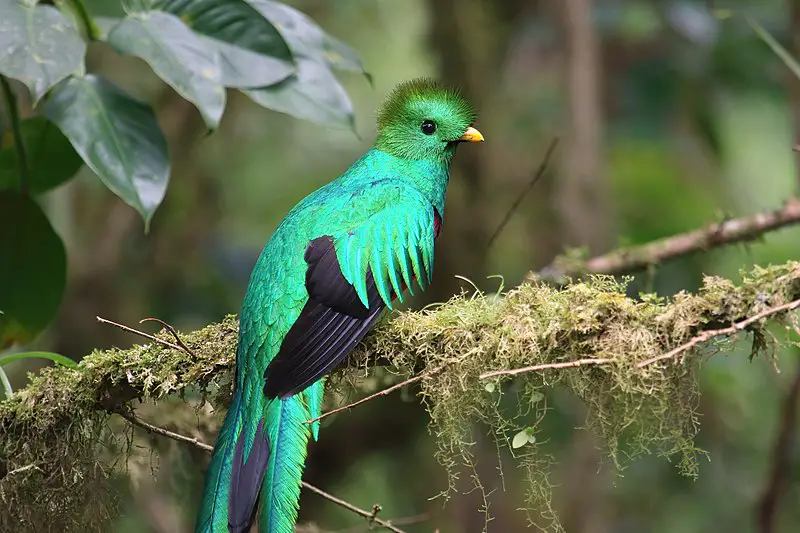
The resplendent quetzal is a beautiful and vibrant bird found in Central America. It belongs to the family Trogonidae, which includes birds like trogons and motmots.
This species of quetzal has two recognized subspecies: P. mocinno and P. costaricensis, both living in tropical forests such as montane cloud forests.
They are omnivores, typically eating fruits from various plants along with insects, lizards or eggs when available.
The male’s plumage is particularly striking with its multi-colored feathers ranging from green to blue to red that gives it its namesake “resplendence” look.
This coloration comes at a price for males because their bright colors make them more visible predators than females who have duller brown coloring instead.
Regardless of gender though all members of this species demonstrate great agility in flight due to their long tails which help stabilize them even through tight turns.Scientific classification:
| Kingdom | Animalia |
| Phylum | Chordata |
| Class | Aves |
| Order | Trogoniformes |
| Family | Trogonidae |
| Genus | Pharomachrus |
| Species | P. mocinno |
Also Featured In: Most Beautiful Birds in Guatemala,
21. Black-Banded Woodcreeper
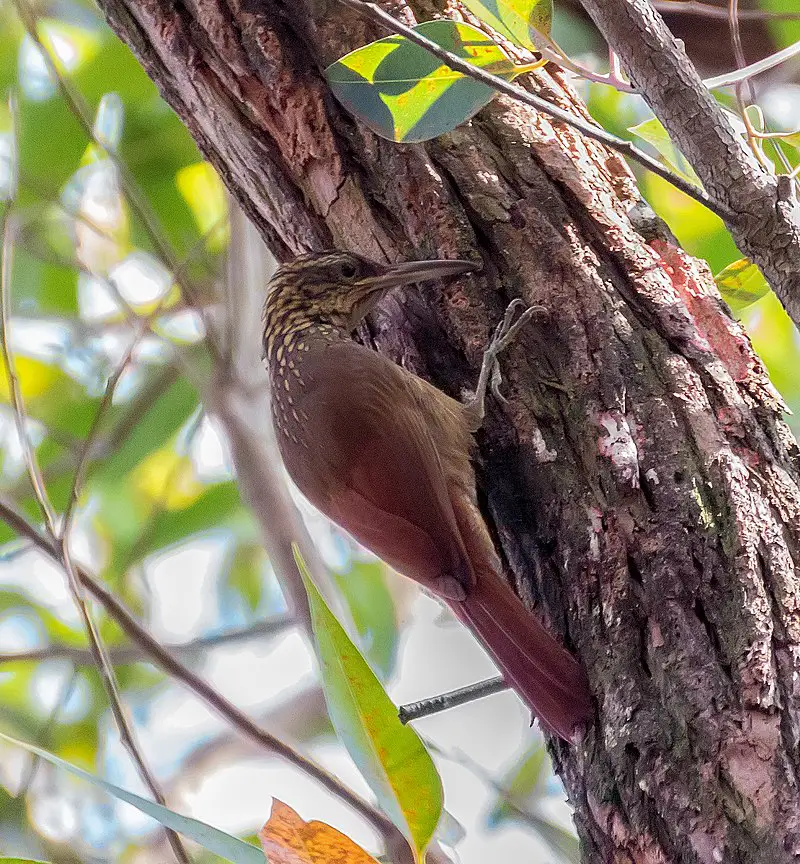
The Black-banded Woodcreeper is a species of bird found in the Dendrocolaptinae subfamily.
It lives across Central and South America, from Chiapas to Paraguay and northern Argentina, inhabiting both lowland subtropical or tropical forests as well as montane ones.
These birds are mainly brown with black bands on their wings that makes them easily recognizable when they fly away.
They feed mostly on insects by probing into tree bark for them using their long curved bills.
The first record of this species was made back in 1789 but its population remains stable so far due to conservation efforts put forth by many organizations around the world who dedicate themselves to protecting these beautiful creatures and their habitats.Scientific classification:
| Kingdom | Animalia |
| Phylum | Chordata |
| Class | Aves |
| Order | Passeriformes |
| Family | Furnariidae |
| Genus | Dendrocolaptes |
| Species | D. picumnus |
Also Featured In: Birds of Bolivia,
22. Eurasian Golden Oriole
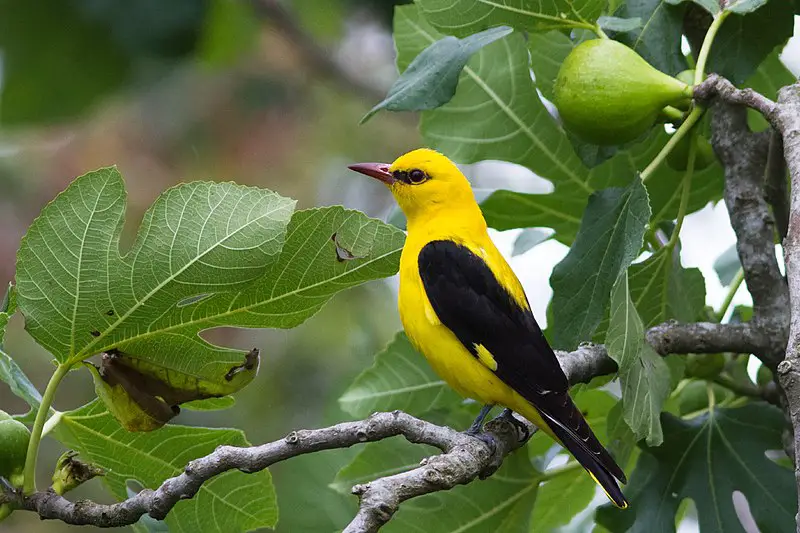
The Eurasian golden oriole is a beautiful bird belonging to the Old World oriole family of passerine birds that breed in temperate climates of the Northern Hemisphere.
It migrates from Europe and Palearctic during summer season, and spends its winter months in central and southern Africa.
These birds have an impressive range with large populations which appear to be stable or increasing across much of their range due to conservation efforts.
They are mostly found near forests, woodlands, riverbanks and meadows where they feed on fruits as well as insects such as caterpillars, beetles, grasshoppers etc.
The males can easily be identified by their bright yellow plumage while females are more olive coloured.
All in all these stunningly colourful creatures add vibrancy to our environment.Scientific classification:
| Kingdom | Animalia |
| Phylum | Chordata |
| Class | Aves |
| Order | Passeriformes |
| Family | Oriolidae |
| Genus | Oriolus |
| Species | O. oriolus |
Also Featured In: Most Beautiful birds of Greece, Turkey Birds You Should Know
23. Grey Parrot
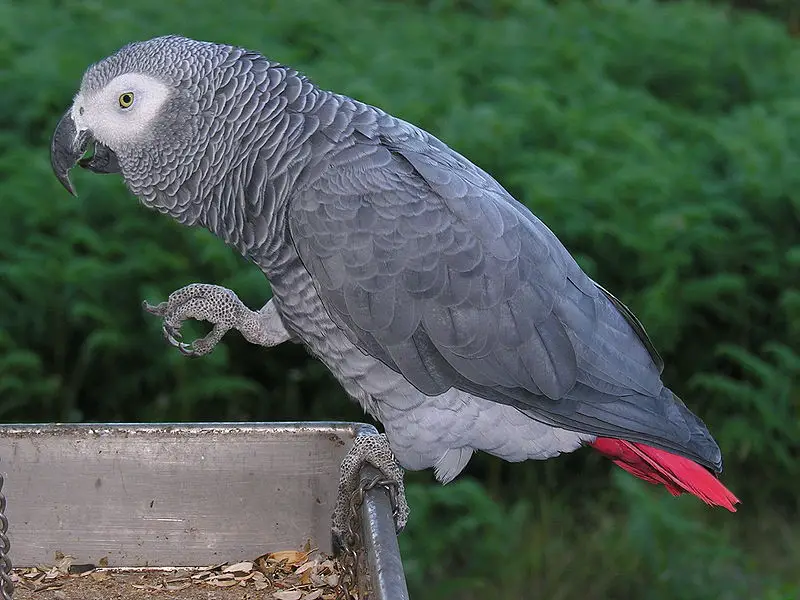
The Grey Parrot, also known as the Congo grey parrot, is a species of Old World parrots belonging to the family Psittacidae.
It was formally described by Swedish naturalist Carl Linnaeus in 1758.
This bird has an ash-grey plumage with bright red tail feathers and white markings around its eyes and beak.
They are very intelligent birds that can mimic human speech and understand basic commands.
Their diet consists mainly of fruits, nuts, seeds, vegetables and insects found in their native African habitat or other tropical regions they inhabit such as rainforests or woodlands.
Grey parrots have become popular pets due to their intelligence and ability to learn complex behaviors like talking back when spoken too.Scientific classification:
| Kingdom | Animalia |
| Phylum | Chordata |
| Class | Aves |
| Order | Psittaciformes |
| Family | Psittacidae |
| Genus | Psittacus |
| Species | P. erithacus |
Also Featured In: Congo Birds, Aviary Birds You Should Know
24. Cotinga
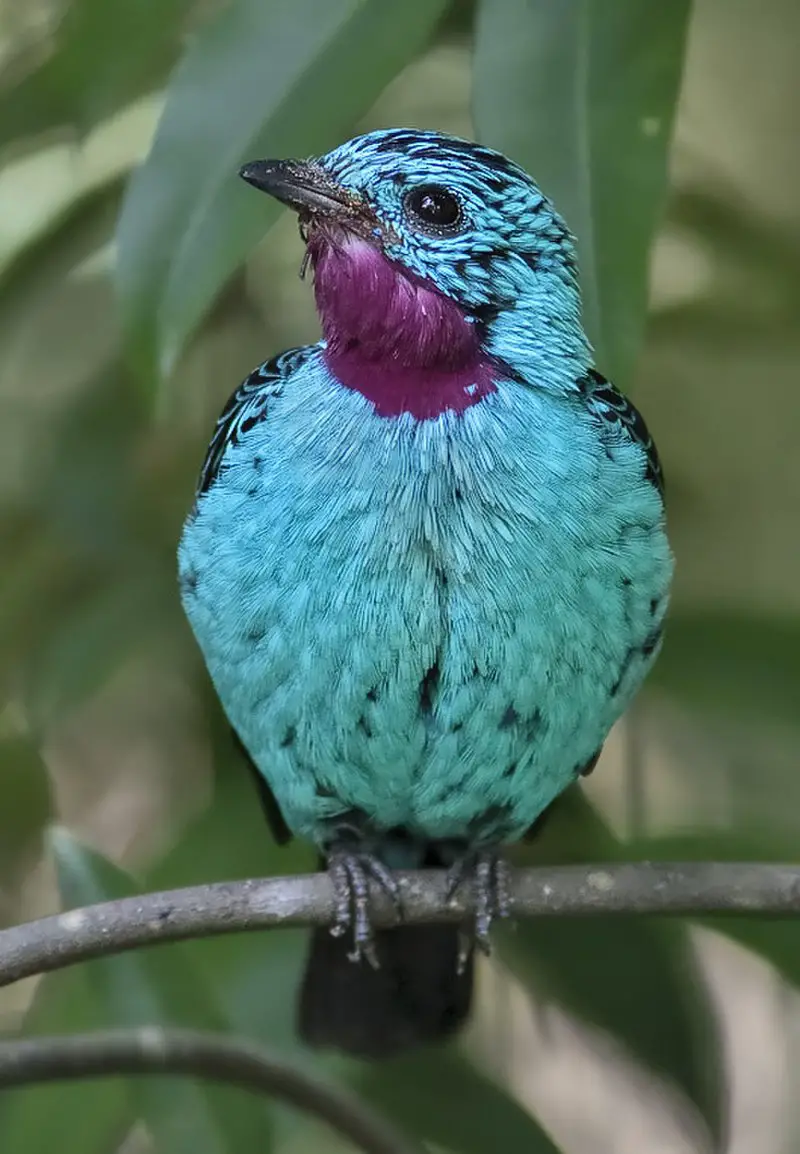
Cotingas are a large family of passerine birds that inhabit Central and South America. They have broad bills with hooked tips, rounded wings, and strong legs.
These colorful birds usually live in forests or forest edges and feed mainly on fruits. Cotinga species range from 12-13 cm (4.7–5.1 inches) to 48-51 cm long depending on the type of bird.
The fiery-throated fruiteater is among the smallest members while others like cocks -of –the rock can reach up to 51cm long.
All these birds display spectacular colors which makes them popular amongst bird watchers all over the world..Scientific classification:
| Kingdom | Animalia |
| Phylum | Chordata |
| Class | Aves |
| Order | Passeriformes |
| Parvorder | Tyrannida |
| Family | Cotingidae Bonaparte, 1849 |
Also Featured In: Costa Rica Birds,
25. Spectacled Owl
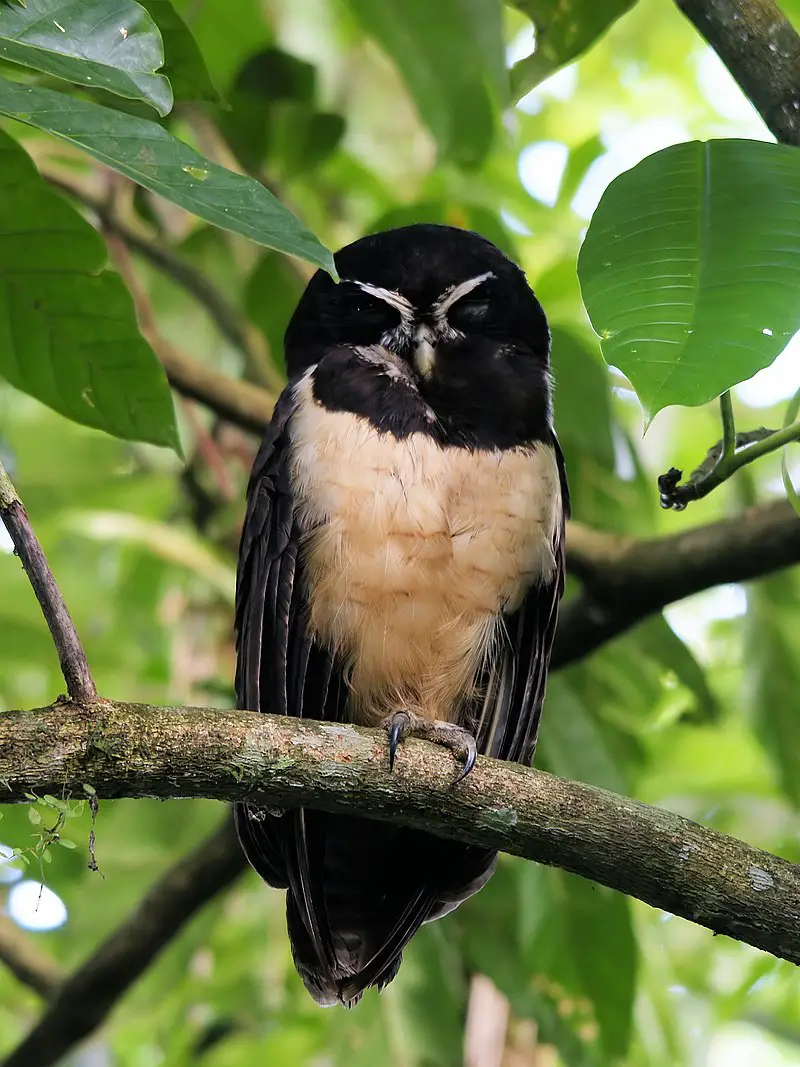
The Spectacled Owl is a large tropical owl that breeds in forests from southern Mexico, Trinidad and Central American countries to Southern Brazil, Paraguay and Argentina.
It has six subspecies with one of them sometimes considered as a separate species called the Short-Browed or Brown Spectacled Owl.
The bird’s body is covered by an array of feathers which are typically dark brown streaked with lighter shades marking its eyes like spectacles; this gives it its name.
Its call could be described as a series of hoots followed by shrieks making it easily distinguishable amongst other owls.
This nocturnal predator feeds mostly on small mammals such as mice while larger prey items include frogs, bats and even birds.Scientific classification:
| Kingdom | Animalia |
| Phylum | Chordata |
| Class | Aves |
| Order | Strigiformes |
| Family | Strigidae |
| Genus | Pulsatrix |
| Species | P. perspicillata |
Also Featured In: Panama Birds,
26. Jungle Myna
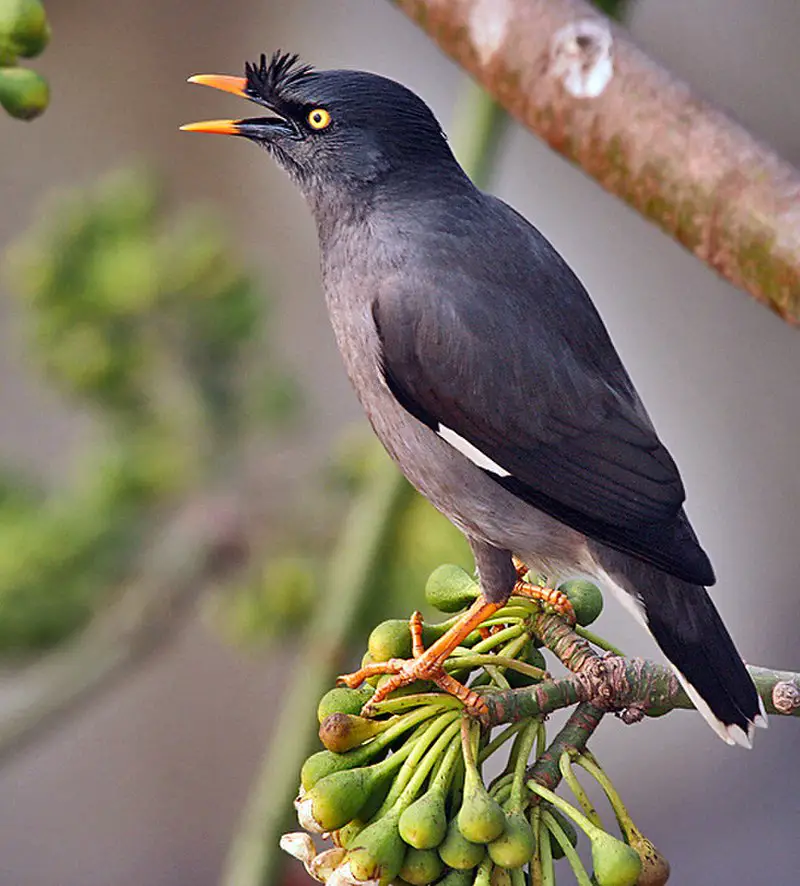
The Jungle myna is an intelligent bird belonging to the starling family. It has a distinct tuft of feathers on its forehead and forms a frontal crest, which makes it easily recognizable.
Its range encompasses much of the mainland Indian Subcontinent but not in arid zones like India.
They are known for their intelligence and ability to mimic human speech, making them popular among pet owners as well as wildlife enthusiasts.
Furthermore, they have also been observed cooperating with other species when searching for food or nesting materials.
The Jungle Myna is often seen near water bodies where it forages for insects such as grasshoppers that make up its most important source of nutrition .
Thus due to these reasons , this beautiful creature should be protected from any harm.Scientific classification:
| Kingdom | Animalia |
| Phylum | Chordata |
| Class | Aves |
| Order | Passeriformes |
| Family | Sturnidae |
| Genus | Acridotheres |
| Species | A. fuscus |
Also Featured In: Cook Islands birds, Birds That You’ll See in Kaziranga National Park
27. Shikra
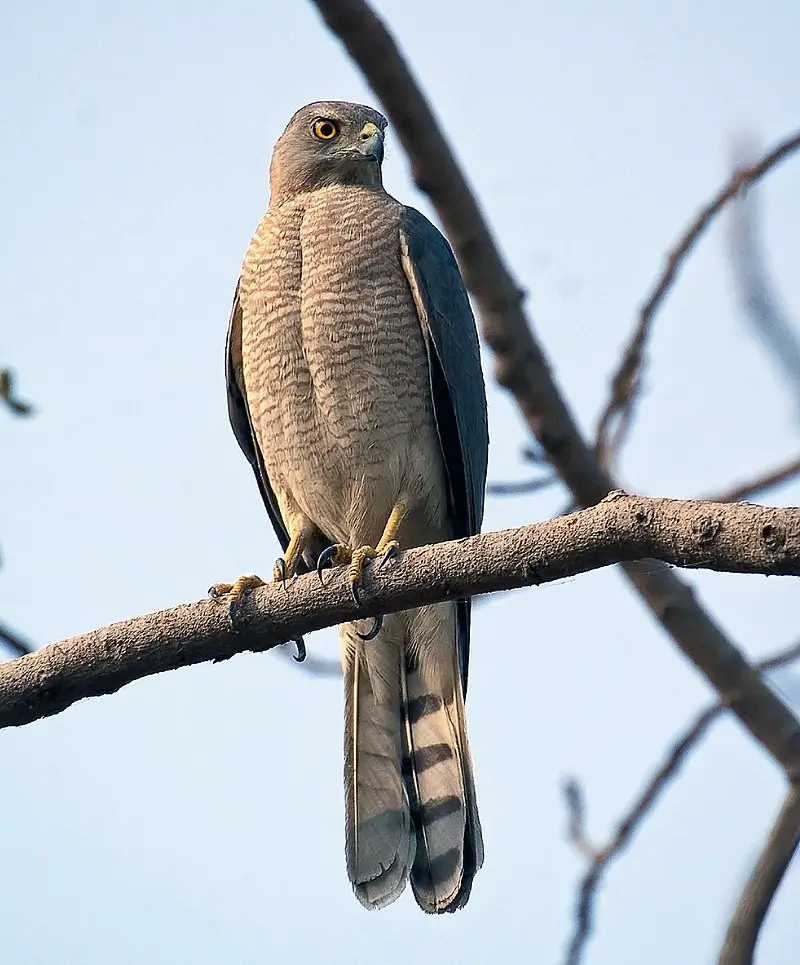
The Shikra bird, also known as the little banded goshawk, is a widespread bird of prey found in Asia and Africa. It is a small species belonging to the Accipitridae family.
The African variations of the Shikra may potentially represent a distinct species, but they are usually considered subspecies.
This bird has physical similarities to other sparrowhawk species, such as the Chinese Goshawk and Eurasian Sparrowhawk.
The Shikra is a quick predator and possesses excellent hunting skills. It typically preys on small mammals, reptiles, and birds.
The bird is known for its distinctive hunting technique, which involves a sudden dash and a quick silent strike to capture its victim.
Its plumage consists of brown or greyish-brown feathers with white and fine black streaks.
Overall, the Shikra bird is an impressive bird of prey, known for its versatility and hunting prowess.Scientific classification:
| Kingdom | Animalia |
| Phylum | Chordata |
| Class | Aves |
| Order | Accipitriformes |
| Family | Accipitridae |
| Genus | Accipiter |
| Species | A. badius |
Also Featured In: Native Birds of Kazakhstan, Birds of Goa
28. Oropendola
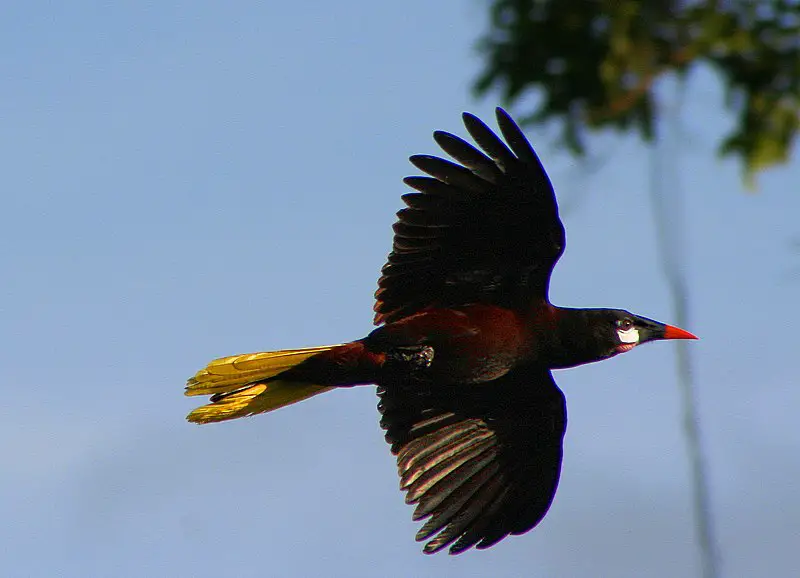
Oropendola birds belong to the Psarocolius genus and are part of the Icteridae family of New World blackbirds. These birds are found in Central and South America.
Their plumage is chestnut with long tails that are partially bright yellow, and they have pointed bills.
Males are usually larger than females. These birds are known for their size and distinctive appearance.
They were once split into different genera, but they are currently classified under Psarocolius.
With their long tails and pointed bills, Oropendola birds are truly unique and fascinating to witness in their natural habitat.Scientific classification:
| Kingdom | Animalia |
| Phylum | Chordata |
| Class | Aves |
| Order | Passeriformes |
| Family | Icteridae |
| Genus | Psarocolius Wagler, 1827 |
Also Featured In: Rainforest Birds You Should Know,
29. True Macaws
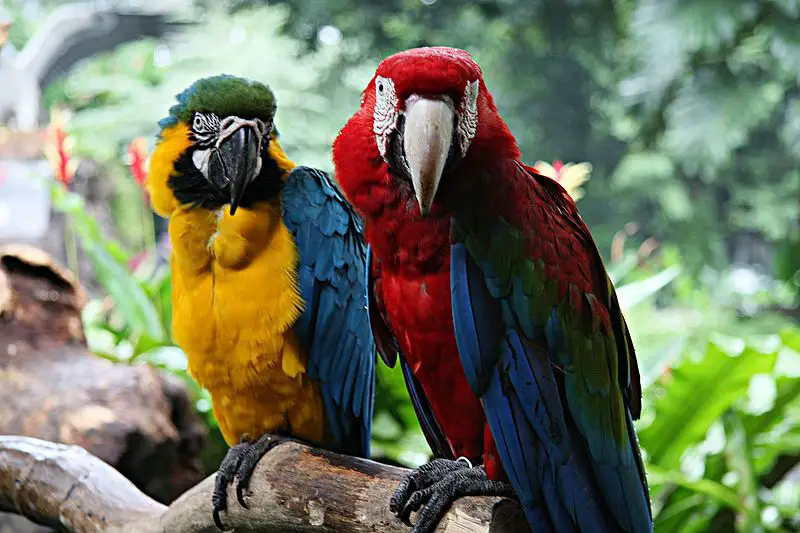
True macaws are a diverse group of parrots belonging to the genus Ara. These colorful birds are found in the Neotropics and are known for their large size and striking plumage.
There are eight extant species of True macaws, each with their own unique colors and patterns.
The genus name Ara was coined in 1799 by French naturalist Bernard Germain de Lacépède and is derived from the Tupi word ará, which is the onomatopoeia for the sound a macaw makes.
True macaws are part of the Arini tribe of neotropical parrots and are highly prized in the pet trade for their beauty and intelligence.
However, many True macaw species are also endangered due to habitat loss and poaching, making conservation efforts crucial for their survival.Scientific classification:
| Kingdom | Animalia |
| Phylum | Chordata |
| Class | Aves |
| Order | Psittaciformes |
| Family | Psittacidae |
| Tribe | Arini |
| Genus | Ara Lacépède, 1799 |
Also Featured In: Common Tropical Rainforest Birds,
30. Cassowaries
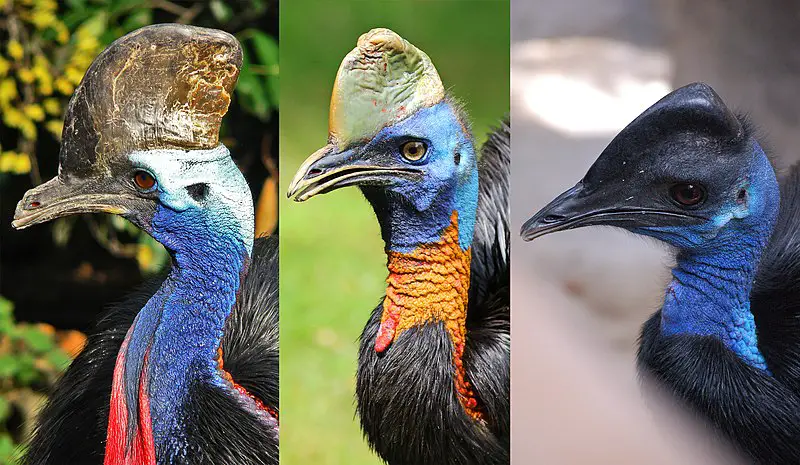
Cassowaries are unique, flightless birds belonging to the genus Casuarius. They are classified as ratites, and they do not have a keel on their sternum bones.
These fascinating birds are found in the tropical forests of New Guinea, Aru Islands, and northeastern Australia. Three species of cassowaries still exist, with the most prevalent being the Southern cassowary.
They are known for their crest, which protrudes from their heads, and their bright blue skin on their neck and head.
Cassowaries are also known for their sharp talons that can grow up to 12 centimeters long, and they can jump up to 1.5 meters high.
Cassowaries are often described as being dangerous as they have been known to attack humans when provoked, but they also play a vital role in their ecosystem as seed dispersers.Scientific classification:
| Kingdom | Animalia |
| Phylum | Chordata |
| Class | Aves |
| Infraclass | Palaeognathae |
| Order | Casuariiformes |
| Family | Casuariidae Kaup, 1847[1] |
| Genus | Casuarius Brisson, 1760 |
Also Featured In: Birds You’ll Find in Zoo, Most Common Nature Birds
31. Junglefowl
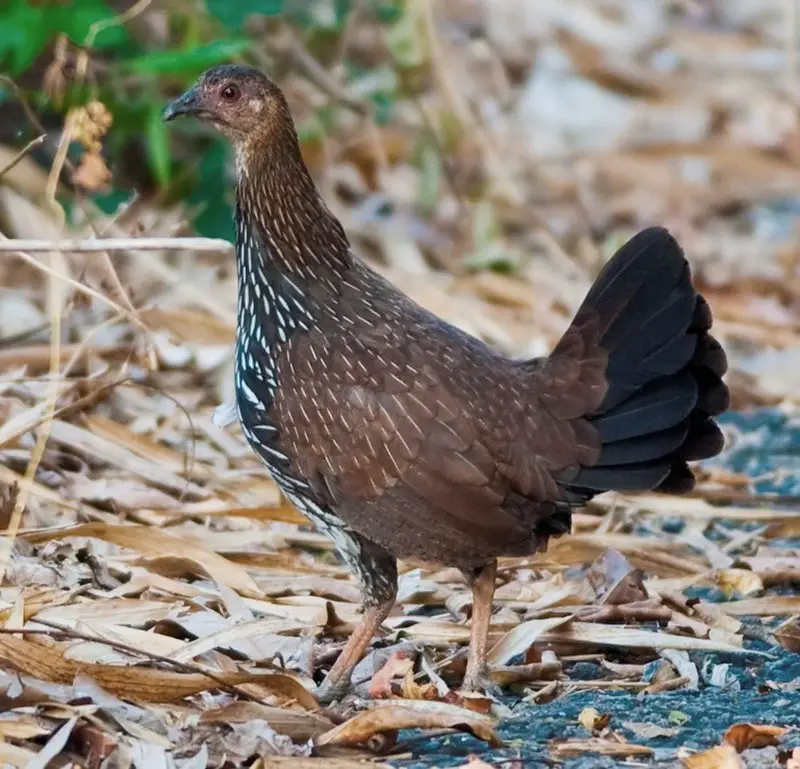
The Junglefowl bird belongs to the species of Galliformes and is found mainly in South and Southeast Asia. This bird group diverged from their ancestral species around 4-6 million years ago.
Interestingly, the remains of the Junglefowl have also been discovered in Chile, which indicates its existence in Polynesia at some point. It is among the only four bird species of the genus Gallus.
Despite being an Asian bird, it has been found in other regions, making it versatile, rather than a localized species.
The Junglefowl possesses vibrant feathers, adding an aesthetic appeal. The bird’s beauty compliments its iconic loud crowing sounds.Scientific classification:
| Kingdom | Animalia |
| Phylum | Chordata |
| Class | Aves |
| Order | Galliformes |
| Family | Phasianidae |
| Tribe | Gallini |
| Genus | Gallus Brisson, 1760 |
32. Chiribiquete Emerald
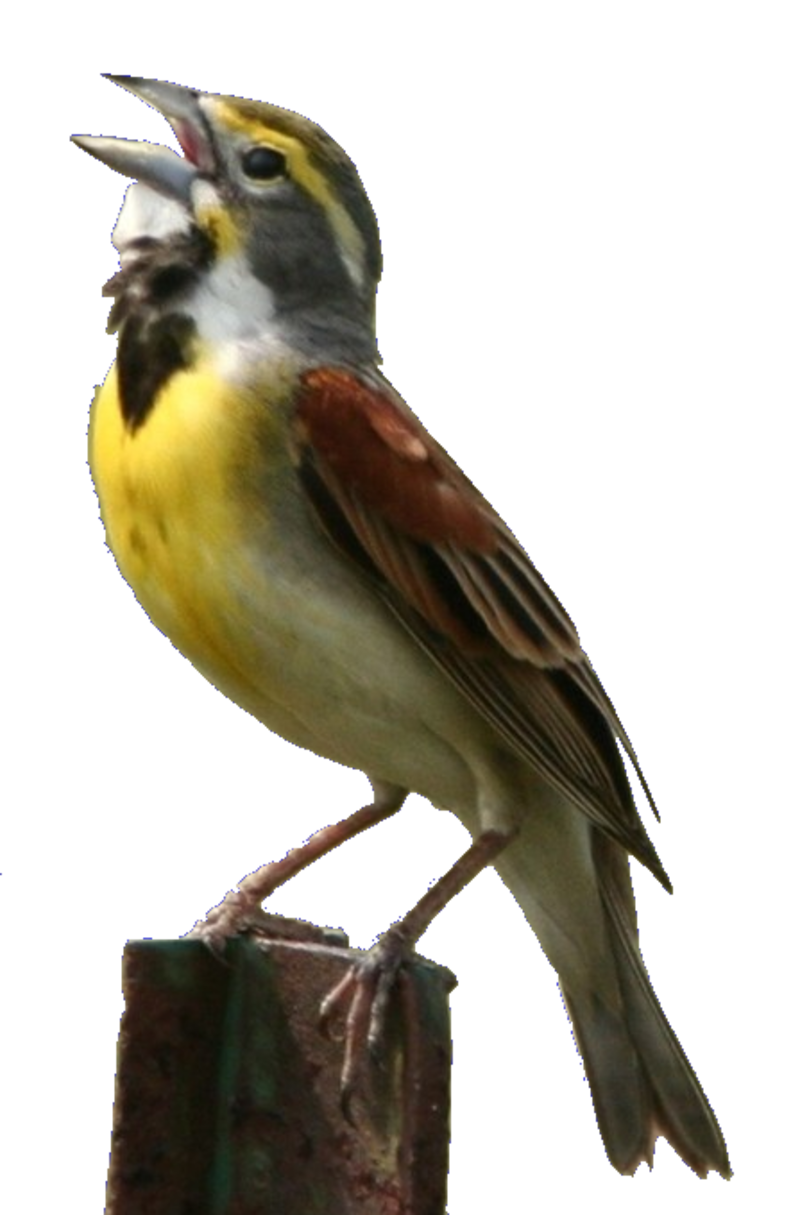
The Chiribiquete emerald is a hummingbird species belonging to the Trochilini tribe of subfamily Trochilinae. It can be found exclusively in southern Colombia.
This bird was named in honor of Fr. Antonio Olivares, who is recognized for his contributions to Colombian ornithology and building a bird collection.
The Chiribiquete emerald was first described in 1996 and is a small sized bird with an emerald green plumage.
Like other hummingbirds, it feeds primarily on nectar and small insects.
This rare and beautiful bird is a unique representation of Colombia’s rich biodiversity, and its natural habitat must be protected to prevent it from becoming endangered or extinct.Scientific classification:
| Kingdom | Animalia |
| Phylum | Chordata |
| Class | Aves |
| Clade | Strisores |
| Order | Apodiformes |
| Family | Trochilidae |
| Genus | Chlorostilbon |
| Species | C. olivaresi |
33. Cock-Of-The-Rock
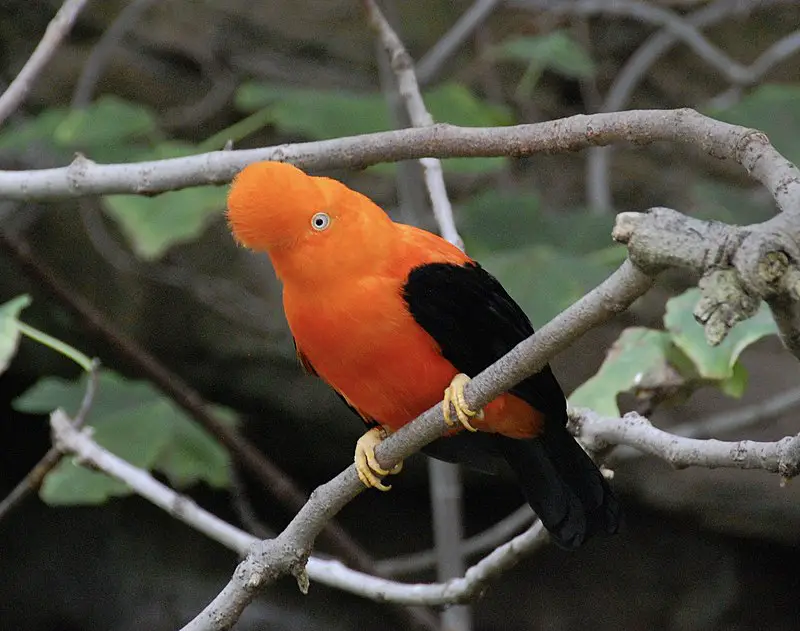
Cock-of-the-rock birds belong to the Rupicola genus and are found in South America. They are large and are part of the cotingid family. These birds usually live in rainforests and are generally found close to rocky areas.
This is also where they build their nests. The species were first documented in the mid-1700s during a research expedition.
The Cock-of-the-rock is known for its unique appearance, with males having bright orange heads and chests.
They are popular among bird watchers and are often featured in nature documentaries. Due to habitat loss and hunting, the population of these birds is decreasing.
Conservation efforts are being made to protect them and their natural habitat.Scientific classification:
| Kingdom | Animalia |
| Phylum | Chordata |
| Class | Aves |
| Order | Passeriformes |
| Family | Cotingidae |
| Genus | Rupicola Brisson, 1760 |
34. Violetear
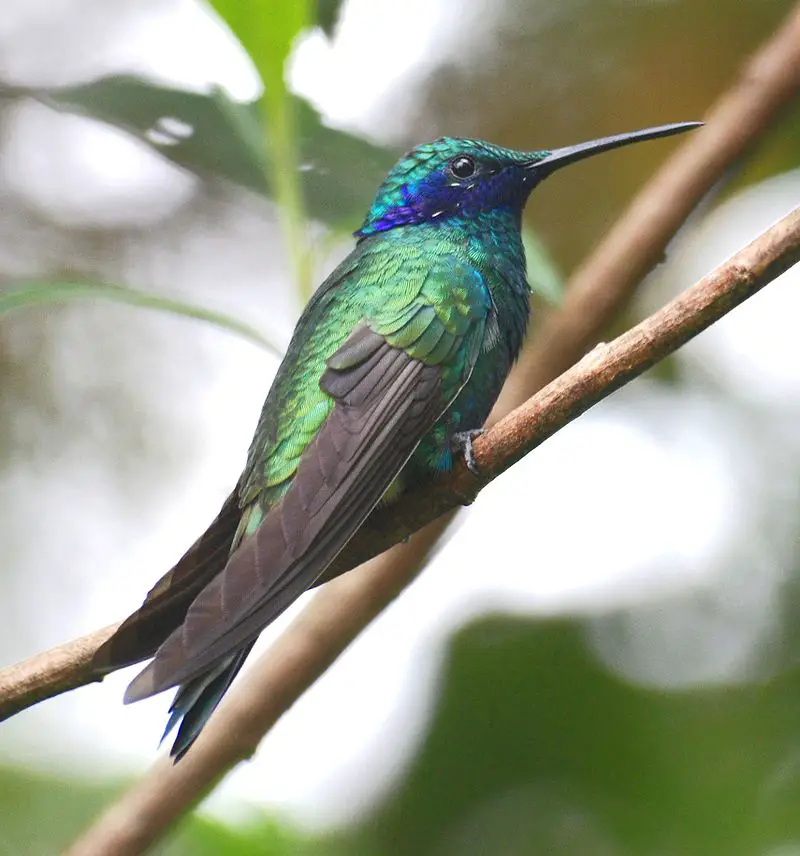
Violetears are a group of hummingbirds found in Mexico, Central and northern South America. They are medium to large-sized birds with rounded tails and short or medium black bills.
Most species have predominantly green plumage, but the males have a violet-blue patch on their throats.
The Mexican violetear sometimes migrates to the United States and Canada. These birds are known for their hovering and darting flight patterns, and their ability to beat their wings up to 80 times per second.
They mainly feed on nectar from flowers, but will also catch insects in flight as a protein source.
Violetears play an important role in pollination and are a cherished sight for birdwatchers in their natural habitats.Scientific classification:
| Kingdom | Animalia |
| Phylum | Chordata |
| Class | Aves |
| Clade | Strisores |
| Order | Apodiformes |
| Family | Trochilidae |
| Subfamily | Polytminae |
| Genus | Colibri Spix, 1824 |
35. Castelnau’s Antshrike
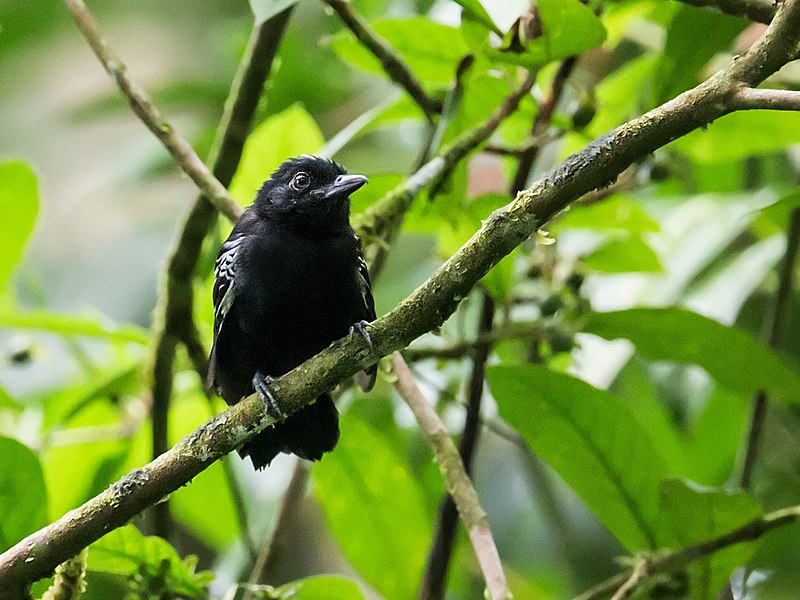
The Castelnau’s antshrike bird is a member of the Thamnophilidae family and is mainly found in Brazil, Colombia, Ecuador, and Peru.
It typically inhabits riverine subtropical or tropical moist lowland forests and heavily degraded former forests.
This bird species is known for its unique characteristics and features. It is small in size, has a distinctive beak, and is known for its often secretive and elusive behavior.
The Castelnau’s antshrike bird is a inquisitive and curious creature, which has garnered interest from bird enthusiasts across the globe.
Unfortunately, due to habitat loss and deforestation, the Castelnau’s antshrike bird population has declined in recent years.
Conservation efforts are being made to protect this species and ensure its survival for future generations.Scientific classification:
| Kingdom | Animalia |
| Phylum | Chordata |
| Class | Aves |
| Order | Passeriformes |
| Family | Thamnophilidae |
| Genus | Thamnophilus |
| Species | T. cryptoleucus |
36. Jungle Prinia
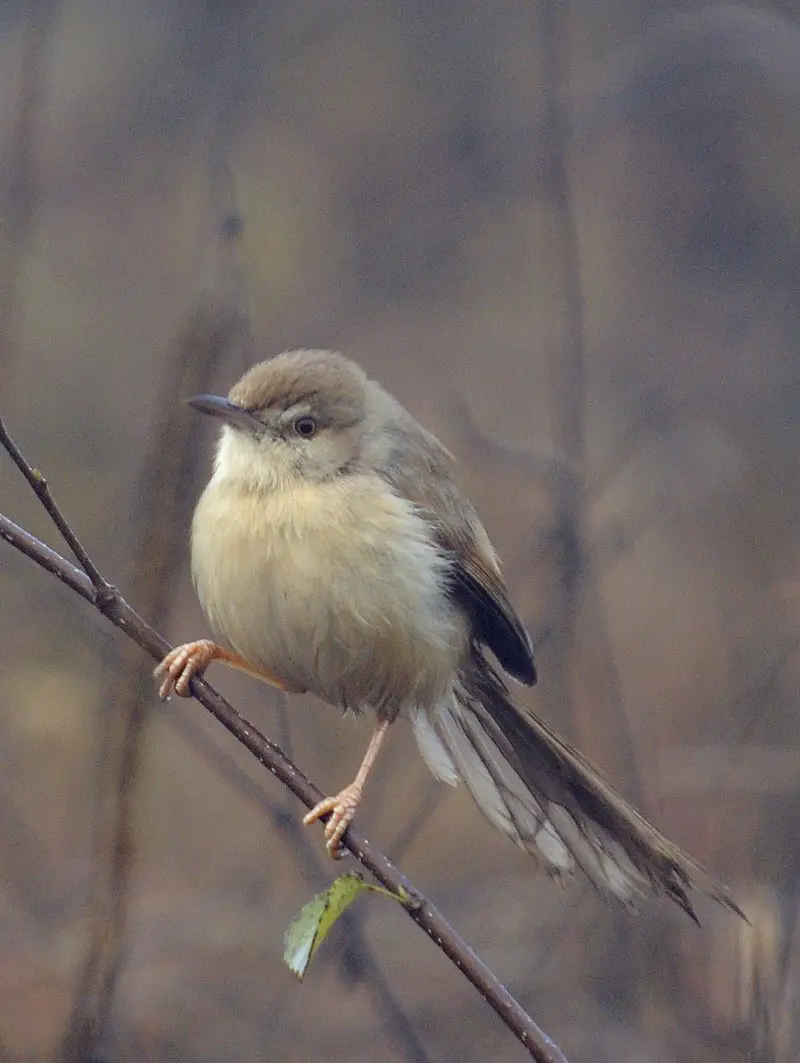
The Jungle Prinia is a small warbler bird from the Cisticolidae family that can be found in India, Bangladesh, southwestern Nepal, and Sri Lanka.
It is usually seen in dry, open grasslands and woodlands, as well as in gardens and scrub areas.
This bird has a short, black bill, strong legs, and short, rounded wings, as well as a longish tail. Jungle Prinias are usually around 15 cm long.
As a resident breeder in the regions where it is found, this bird is known for building nests in shrubs or low trees.
Its coloring is mainly brown, with a greyish underbelly. It is usually seen alone or in small groups and is known for its sweet, melodic song.Scientific classification:
| Kingdom | Animalia |
| Phylum | Chordata |
| Class | Aves |
| Order | Passeriformes |
| Family | Cisticolidae |
| Genus | Prinia |
| Species | P. sylvatica |
Also Featured In: Gujarati Birds, Birds that Live in Rajasthan
37. Eastern Jungle Crow
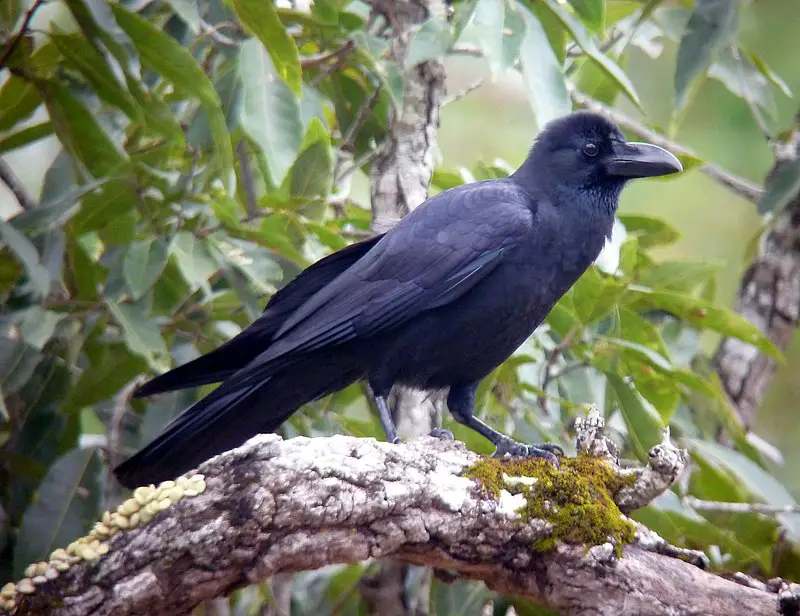
The Eastern jungle crow belongs to the Corvidae family and can be found in countries like China, Bangladesh, India, Bhutan, Thailand, Myanmar, and Nepal.
This bird is known for its glossy black feathers and its peculiar calls that echo through the dense forests it inhabits.
The Eastern jungle crow has a sharp beak and is known to be an omnivorous bird that feeds on fruits, insects, and small animals.
Its adaptability to different environments has made it a common sight in various areas. The Eastern jungle crow is also known to be highly intelligent and is often compared to other intelligent birds like the crow and raven.
Although they are not endangered, they face threats from habitat destruction and hunting.
These birds play a vital role in the ecosystem and act as both predators and scavengers, helping to maintain the balance of nature.Scientific classification:
| Kingdom | Animalia |
| Phylum | Chordata |
| Class | Aves |
| Order | Passeriformes |
| Family | Corvidae |
| Genus | Corvus |
| Species | C. levaillantii |
38. Long-Tailed Shrike
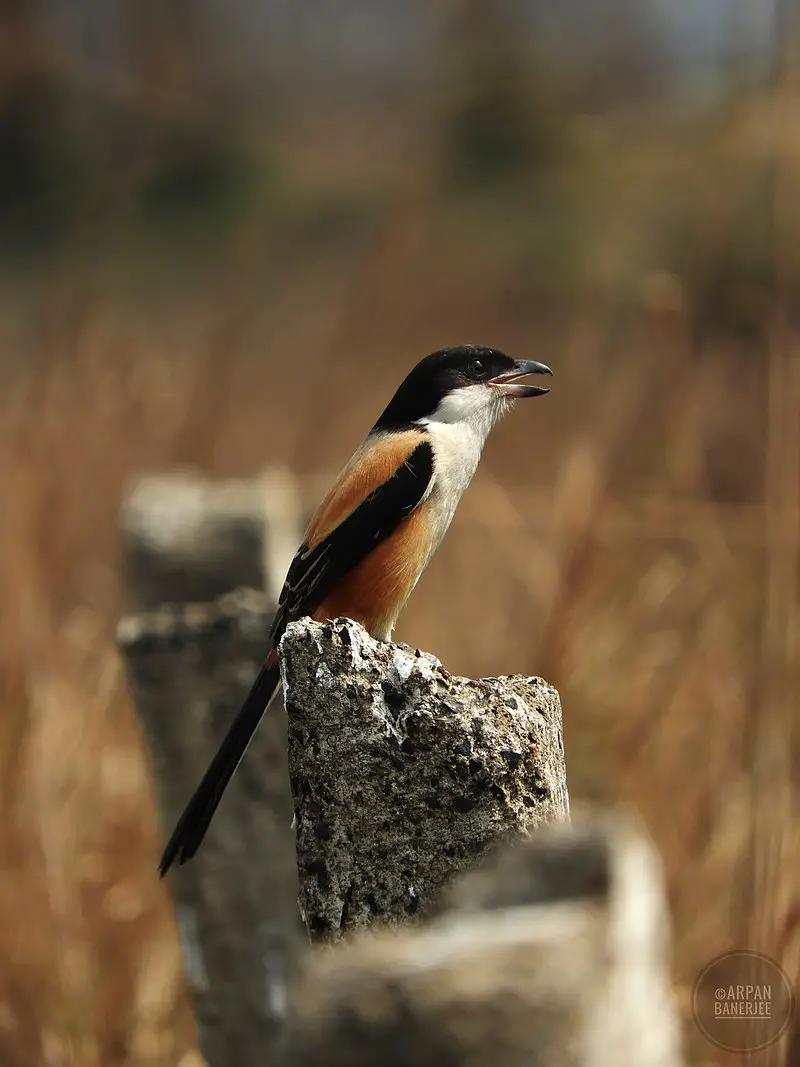
The Long-tailed shrike, also known as the rufous-backed shrike, belongs to the shrike family and is found throughout Asia.
Their appearance varies across their wide range, but they are known for their long tail and rufous-colored back.
In some areas, they are called the black-headed shrike. These birds prefer open habitats such as grasslands and farmland, where they hunt insects, lizards, and small birds
They are known for impaling their prey on thorns or barbed wire, making them easy to find.
Long-tailed shrikes are territorial and often seen perched on a high vantage point, scanning their surroundings for prey or intruders.
They are adaptable to human-made environments and have even been seen in cities. Despite their widespread range, their population is decreasing due to habitat loss and fragmentation.Scientific classification:
| Kingdom | Animalia |
| Phylum | Chordata |
| Class | Aves |
| Order | Passeriformes |
| Family | Laniidae |
| Genus | Lanius |
| Species | L. schach |
Also Featured In: Common Birds in the Cities, Common Birds of Maharashtra
39. Spotted Owlet
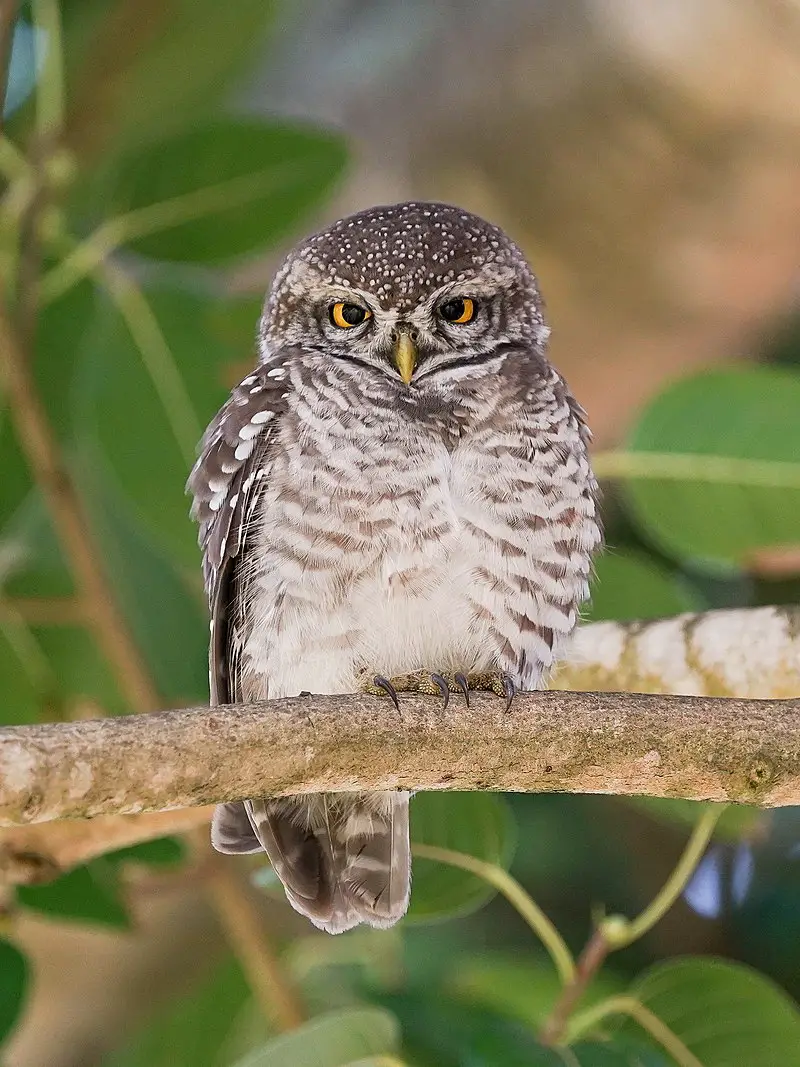
The Spotted owlet, also known as Athene brama, is a small bird species found in tropical Asia, from mainland India to Southeast Asia. It is a common resident of open habitats, including farmland and human habitation.
This bird has adapted well to living in urban areas and can be found roosting in small groups in cavities of trees, rocks or buildings.
They typically nest in holes in trees or buildings and lay 3-5 eggs. The Spotted owlet has shown great adaptability to changing environments and has learned to coexist with humans in urban settings.
This bird is known for its distinctive spotted appearance and has become a well-loved sight in many parts of Asia.Scientific classification:
| Kingdom | Animalia |
| Phylum | Chordata |
| Class | Aves |
| Order | Strigiformes |
| Family | Strigidae |
| Genus | Athene |
| Species | A. brama |
Also Featured In: Common Birds that Live in Odisha, Common Birds in Bangalore